A9 Luncarty to Pass of Birnam
Overview
The A9 between Perth and Inverness is undergoing a major upgrade from single to dual carriageway. The Luncarty to Pass of Birnam section encompasses 9.5km of the A9 has been widened as part of the dualling programme, improving journey times and safety on the route.
The scheme was built on behalf of Transport Scotland by Balfour Beatty. The newly dualled section opened to traffic in August 2021 and is operated and maintained by Bear Scotland.
Why it's needed
Our aim was to reduce journey times and make them more reliable. Alongside this, the project aimed to improve integration with public transport facilities, mitigate the environmental impact of the road and facilitate active travel such as walking and cycling.
The construction journey
The construction works to dual the existing 9.5km of single carriageway north of Perth began in earnest in February 2019, with the installation of traffic management restrictions, following the appointment of Balfour Beatty as the main contractor in September 2018.
All traffic management including lane and speed restrictions were removed from the project roads on Saturday 28 August, 2021, allowing road users access to the 9.5 km of new dual carriageway between Luncarty, north of Perth, and the Pass of Birnam for the first time.
The opening of this most southerly section of the A9 Dualling programme to four lanes of traffic now provides 15 km of continuous dual carriageway from Inveralmond Roundabout to Birnam.
This important project milestone also included the opening of 4 km of new and upgraded non-motorised user (NMU) route, which now connects the surrounding communities to Scotland’s core path network. The routes will promote active travel and encourage people to walk, wheel and cycle for everyday journeys. Find further information on the NMU routes.
The detail
The existing 9.5km stretch of single carriageway has been widened to full dual carriageway standard, providing safe and guaranteed overtaking opportunities in both directions.
All existing junctions on the project that provided direct access to the A9 have been closed and replaced with new or upgraded junctions, which now provide safe access to and from the A9 via slip-lanes. These include the new Stanley/Tullybelton Junction and the significant upgrade of Bankfoot North and Bankfoot South Junctions. A number of new access roads and tracks have also been constructed to provide properties with safe access to the local road network and the new and improved grade separated junctions.
Four new overbridges have been constructed to maintain local access across the A9. These are known as Pitlandie, Stanley/Tullybelton, Coltrannie and Gelly overbridges . The project also included the widening of one existing underbridge at Hunter’s Lodge, which carries the A9 at Bankfoot North Junction, and a new side road bridge on the U32. Other structures, such as retaining walls and culverts have also been constructed.
The project also included:
- two new northbound laybys and one new southbound layby, each with 70m of parking
- 4km of new and upgraded paths to encourage active travel for pedestrians, cyclists and equestrians, including a new link between Luncarty and Bankfoot
- a drainage scheme developed in accordance with Sustainable Drainage Systems (SUDS) and Scottish Environment Protection Agency (SEPA) guidance
Community engagement
Community engagement is a priority with all of our projects. Working with those affected by the A9 dualling programme is at the heart of our planning and we regularly run engagement events to consult local communities, road users, businesses and individuals as our plans are progressed.
Meet the contractor – Public exhibitions - December 2018
Our contractor responsible for the design and construction of the A9 Dualling Programmebetween Luncarty and the Pass of Birnam, held a series of public exhibitions for residents of Bankfoot, Stanley and Luncarty on 3, 10 and 11 December 2018, respectively.
These events provided an opportunity to meet with key people involved in the project and to learn more about the construction phase in advance of the main works commencing in early 2019.
These events were supported by senior team members from our contractor: Balfour Beatty, Atkins and Jacobs as well as representatives from Transport Scotland.
Public exhibitions - April 2014
Exhibitions were held in Bankfoot on 2 and 3 April 2014 to update the public on the Luncarty to Pass of Birnam dualling scheme.
- A9 Luncarty to Pass of Birnam exhibition panels
- A9 Luncarty to Pass of Birnam leaflet
- A9 Luncarty to Pass of Birnam feedback form
Public exhibitions - January / February 2012
Previously we hosted public exhibitions in January / February 2012 to give everybody the opportunity to see potential route options.
The exhibition boards are available in two parts:
Operation and Maintenance
The A9 Dualling: Luncarty to Pass of Birnam project was opened to traffic on 28 August 2021.
Our contractor for the project, Balfour Beatty is responsible for the landscape maintenance of the works until December 2026. This includes ensuring that the planting matures successfully and the replacement of any planting that has not established.
BEAR Scotland is responsible for the operation and all other maintenance on this section of the A9 trunk road on behalf of Transport Scotland.
From time to time, traffic management may be required to maintain the road network.
For updates on operation and maintenance, see the Traffic Scotland website, or follow @NWTrunkRoads and @trafficscotland on Twitter.
For general enquiries please contact: enquiries@bearscotland.co.uk
Phone: 01738 448 600
Address: BEAR Scotland, BEAR House, Inveralmond Road, Perth, PH1 3TW
You can report defects via the Report a Defect page or via the Traffic Scotland Customer Care Line (0800 028 1414).
Compensation Claims
Under Part 1 of the Land Compensation (Scotland) Act 1973 (as amended) there is a right to compensation in respect of any depreciation of more than £50 in the value of certain interests in land caused by the use of the new or altered roads resulting from specified physical factors (noise, vibration, smell, fumes, smoke and artificial lighting and the discharge onto the land in respect of which the claim is made of any solid or liquid substance).
Compensation is assessed by reference to prices current at the date 12 months after the road was first open to public traffic, i.e. the "first claim day". Claims should be made within 5 years from the first claim day. However, if an interest is disposed of or (insofar as the interest is in land which is not a dwelling) a tenancy is granted, the claim must be made before such disposal or grant of tenancy.
The A9 Dualling: Luncarty to Pass of Birnam project opened for use by public traffic on 28 August 2021, therefore the relevant date for the purposes of part 1 Claims (i.e. first claim day) is 29 August 2022.
Interests qualifying for compensation are specified in section 2 of the above mentioned Act and there are special provisions relating to claims by heritable creditors, trustees and persons acquiring relevant interests by inheritance. However, no compensation can be paid under Part 1 where part of a property has been acquired for the purpose of constructing or altering the road.
Any person entitled to a qualifying interest who considers he or she has a claim under the said provision should submit their claim to info@transport.gov.scot, addressing the Design Administration Team, Major Projects on or after the first claim day as noted above.
Sustainable and active transport links
In line with the Scottish Government’s National Transport Strategy (NTS2), the A9 Dualling: Luncarty to Pass of Birnam project included the provision of approximately 4km of new and upgraded pedestrian and cycle routes to help promote sustainable and active transport, linking the communities of Luncarty and Bankfoot. Sections of the existing core-paths within the project area were also upgraded with new asphalt surfacing.
View the new non-motorised user (NMU) route between these communities
To promote safe travel for non-motorised users (NMUs), the project replaced existing at-grade core path crossings of the A9 with overbridges between Luncarty and the Pass of Birnam at the following locations:
- Pitlandie
- Coltrannie
- Gelly Wood
A fourth A9 core path crossing located south of Bankfoot was replaced by the new Stanley/Tullybelton overbridge which is located approximately 1km south of the existing crossing point.
The new sections of non-motorised user (NMU) network constructed as part of the project now provide direct connections to the existing core path network between Inveralmond roundabout (Perth) and Luncarty. Linking the communities of Bankfoot and Luncarty through these new sections of active travel network will provide dedicated and safer connections to the wider active travel network; southbound to Perth and northbound along the National Cycle Network (NCN) 77 to Dunkeld and beyond.
These improvements will help connect communities locally and encourage more residents and visitors to make healthy travel choices, providing a cleaner, greener and more sustainable network.
The map showing the new routes created also highlights local visitor attractions and points of recreational interest, as well as connections to the railway network to help plan your journey. To find out more about cycle routes in Scotland, visit the Sustrans website.
Protecting the environment
The design of the scheme was informed by detailed environmental assessments. One of the main considerations was avoiding or reducing adverse effects on the environment.
Transport Scotland published an Environmental Statement in 2014 presenting the outcome of the Environmental Impact Assessment.
Environmental considerations
The region between Luncarty and Pass of Birnam presented a number of unique environmental sensitivities. These included:
- designated sites such as the River Tay, SAC, Cairnleith Moss SSSI and Mill Dam SSSI
- cultural heritage, including listed buildings, archaeological sites and historic landscapes
- protected species such as otters, Atlantic salmon and lamprey
- woodlands including Gelly Wood and Murthly Estate
- low-lying agricultural farmland, undulated hillsides, watercourses and heathland landscapes
- properties in Luncarty, Bankfoot and in isolated rural areas
- access on various cycleways and paths.
Mitigation
The scheme passes through a rural area with some environmentally sensitive and protected areas, as well as running close to several communities.
The project include the following mitigation for environmental impact:
- enhancement of the Gelly Overbridge to support the movement of species across the new A9, with a widened green verge to stimulate biodiversity
- installation of mammal tunnels alongside culverts to support the movement of otter and other species underneath the new A9
- installation of bat boxes in areas of existing woodland
- new and re-routed access tracks and footpaths and new community links, including a cycleway and footway linking Bankfoot and Luncarty
- landscape planting to replace loss of habitat, screen views and integrate the new A9 with its surroundings
- construction measures including pollution control and timing of work to avoid sensitive periods
- incorporating low noise road surfacing and noise barriers into the design to mitigate any noise impacts.
Document library
Construction updates
Autumn 2021
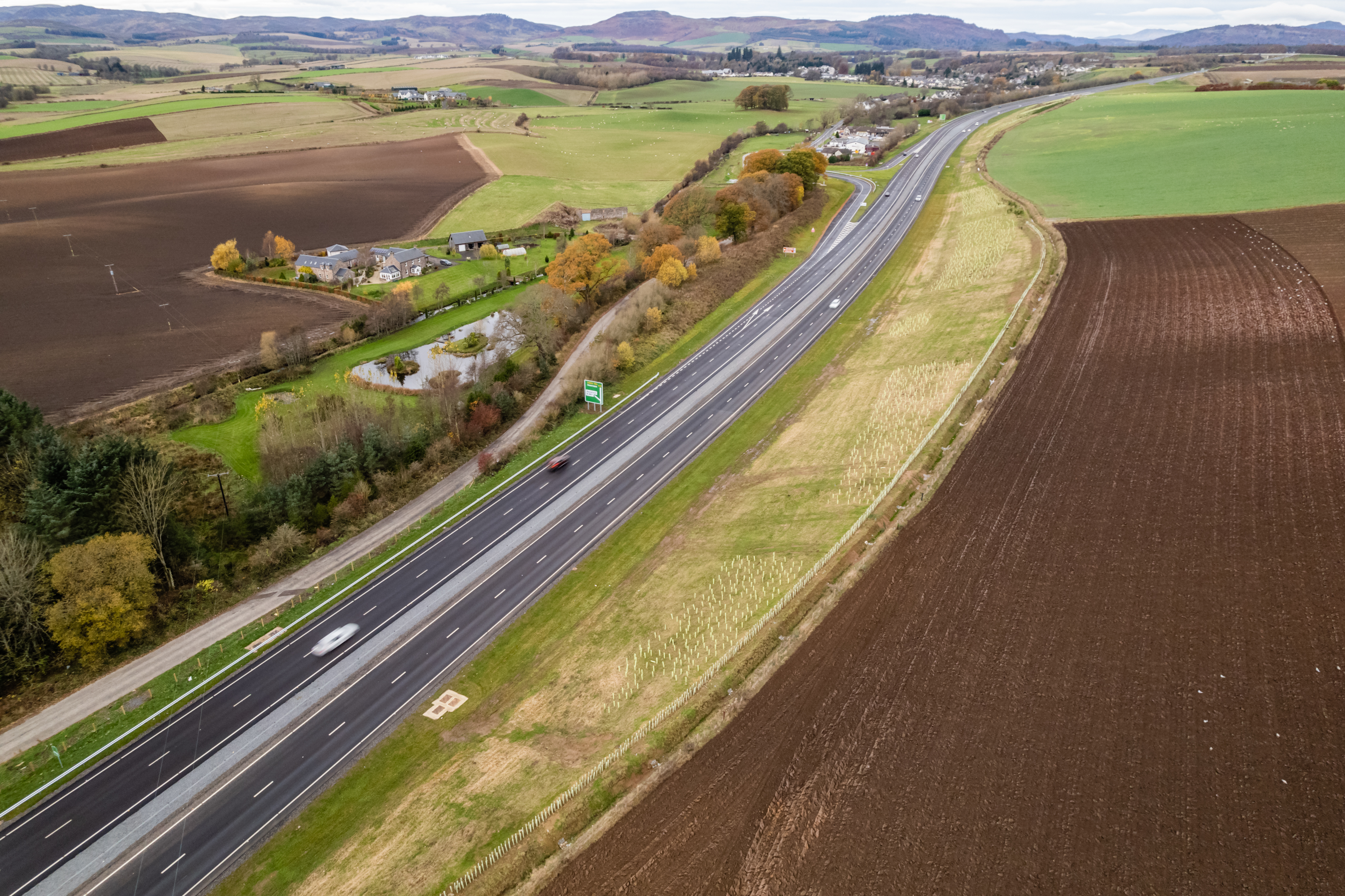
At the onset of the autumn period, the works across the project were substantially complete, and the team celebrated the road being opened to four lanes of traffic at the end of August 2021. Road users were able to enjoy driving on the new A9 dual carriageway for the first time without the traffic management and speed restriction that had been in place since February 2019.
Following the opening of the road, the project team turned its attention to the completion of landscaping and minor remaining works on side roads, which included drainage, fencing and utility works. Although minor in nature, these finishing works can be time consuming to complete on a project of this scale and continued throughout October and November 2021.
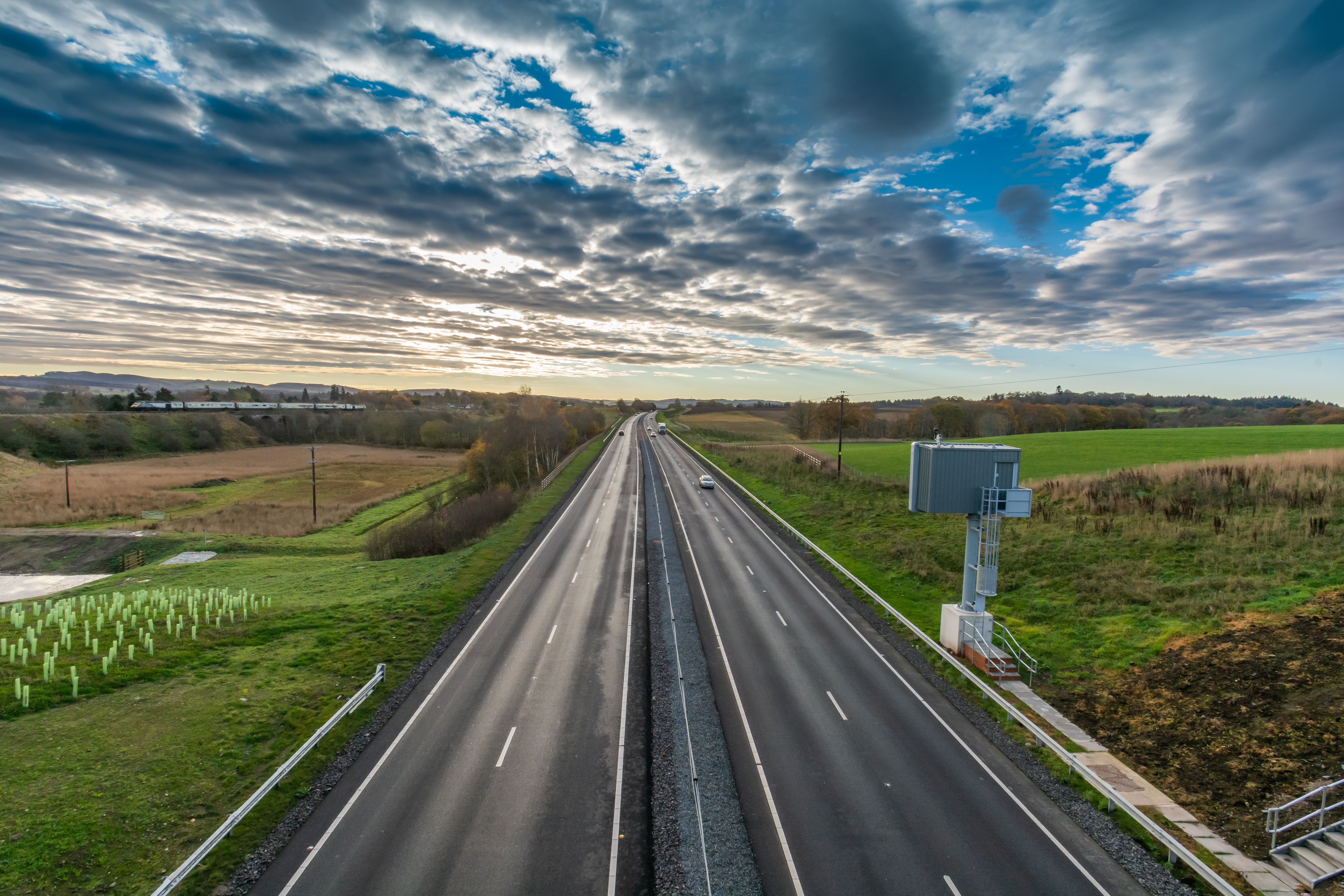
The project team also completed the installation of the Intelligent Transport Systems which combines information, communication and technology to provide road users with real-time journey information helping to improve the operational efficiency of the new trunk road.
This addition will be a significant improvement along the A9 corridor, especially in summer months when traffic volumes are higher due to tourists visiting the Scottish Highlands.
Another important area of finishing works concerned the installation of fibre optic cables which run the length of the project site. These cables provide broadband and telephone communications to the many businesses and residents which surround the project. One of the final jobs following construction of the new road was to connect these new cables to the existing telecoms network at either end of the works.

Away from the construction, the project welcomed the now former Transport Minister Graeme Dey to site at the end of September 2021. Mr Dey met with project partners and members of local community organisations to celebrate the delivery of a wide range of community benefits to the people of Perthshire throughout the project’s construction period.
Stanley Development Trust and charity, Cycling Without Age Scotland, were joined by Mr Dey on trishaws as they explored some of the 4 km of non-motorised users paths, constructed as part of project.
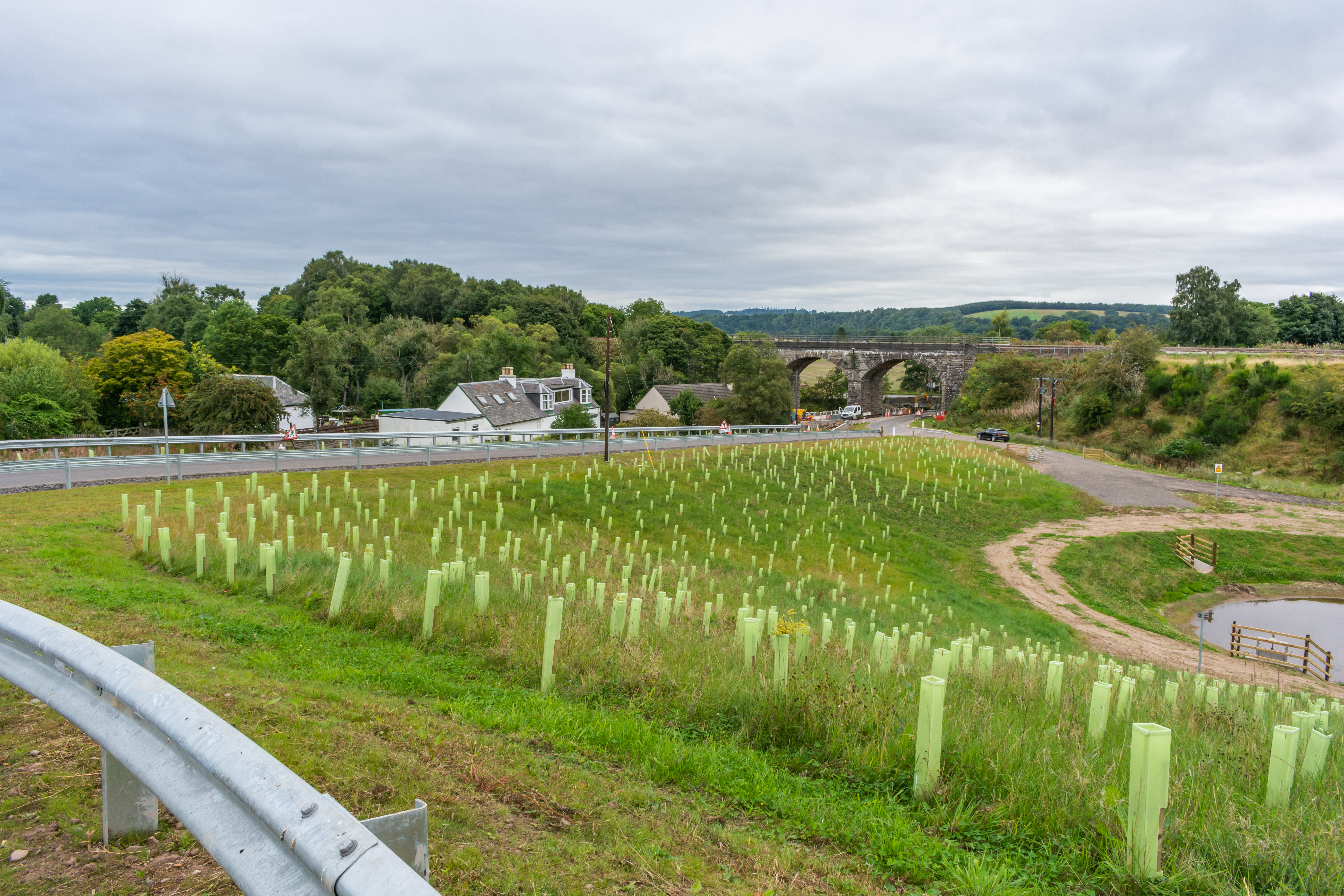
The landscaping works were progressed throughout late autumn and into early winter. These works included grass cutting, landscape preparation and planting of new vegetation to various areas of the site, remote from the A9 carriageways. The planting of new vegetation commenced at the start of the planting season in November, to ensure the new plants/shrubs have the best opportunity to establish.
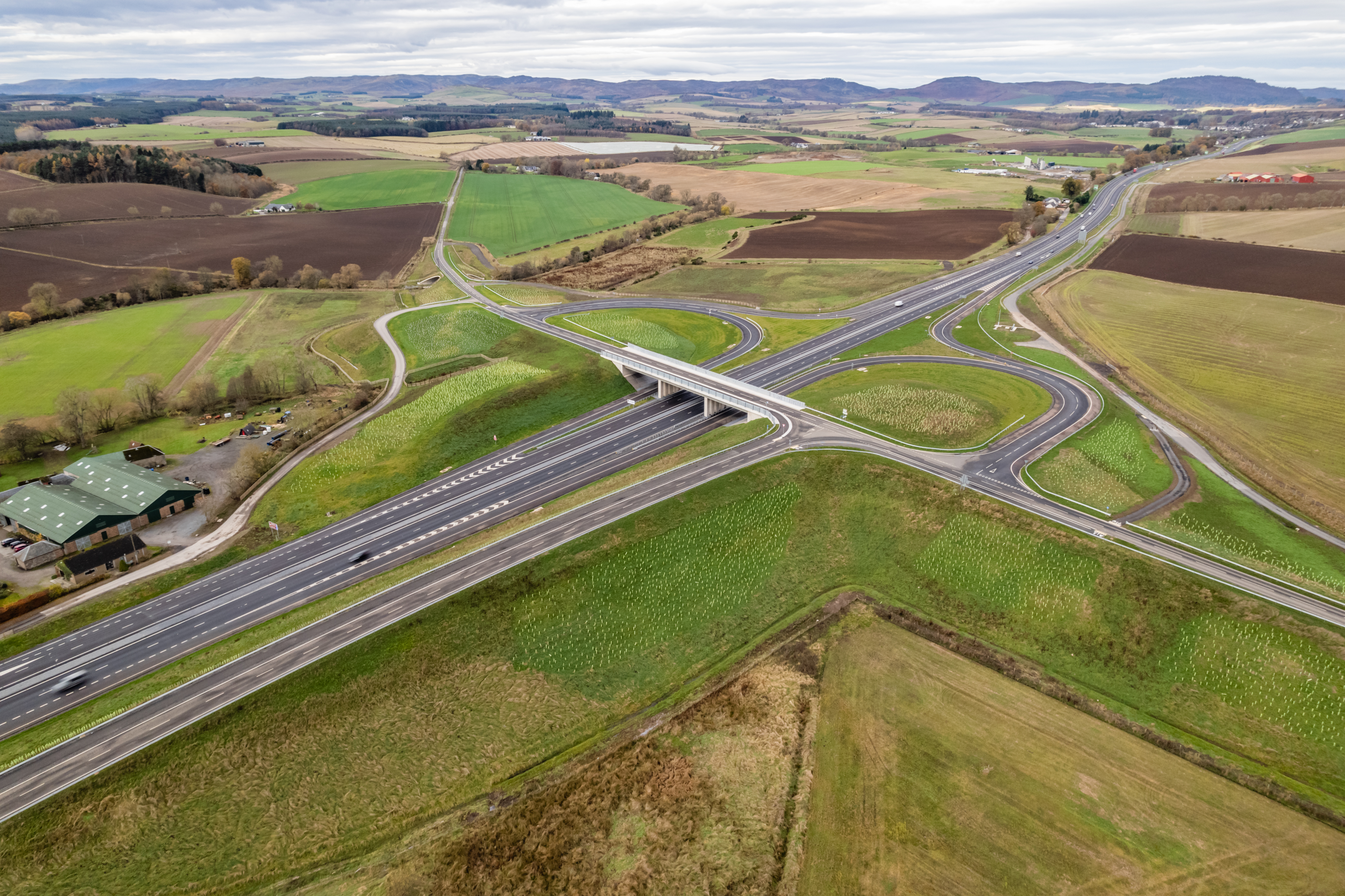
Following completion of the construction phase, landscaping operations continued throughout January 2022. The contractor will continue to oversee the remaining planting and landscaping maintenance until December 2026.
Summer 2021
At the beginning of June, the project reached a significant milestone as the new Stanley/Tullybelton Junction was opened to traffic for the first time, with the on-slip and off-slip to the northbound carriageway under traffic management.

The new junction, which includes the largest structure of the project, has been under construction for more than two years and has used: 268 tonnes of reinforcement steel – the equivalent weight of 34 double decker buses; 1,550 m³ of structural concrete; 15 precast concrete beams and approximately 500,000 m³ of earthworks – enough earth to fill approximately 226 Olympic-sized swimming pools. The earthworks for this junction alone accounted for two thirds of the earthworks for the entire project.
The new junction aims to improve safety for traffic joining and leaving the A9 carriageways with the creation of new northbound and southbound slip roads. By removing right turn manoeuvres from the A9 carriageways, visibility for road users has been enhanced, and access to the communities of Stanley and Tullybelton, as well as to neighbouring properties and businesses, have also been improved.
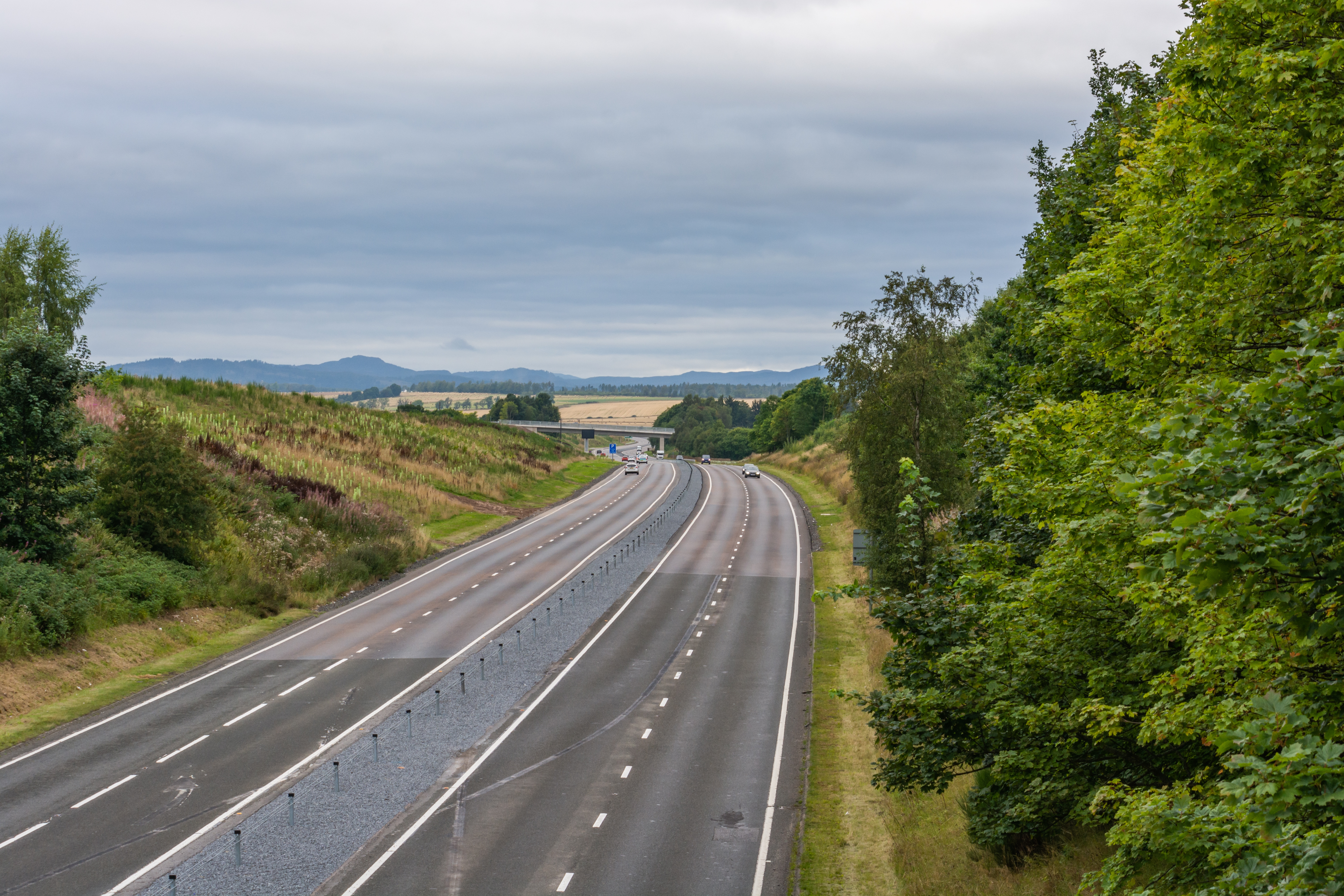
Finishing works to the northbound carriageway verge and the central reservation continued throughout the months of June and July. This included the removal of the temporary central reservation crossover points which were no longer required for traffic management purposes. This allowed the contractor to complete the wire rope central reservation vehicle restraint system along the 9.5km length of the new carriageways.
In addition, the final section of the new northbound carriageway road surface was completed at Bankfoot South Junction in early July. Following completion of the surfacing and central reservation works, the traffic management team was able to switch A9 traffic to run in single lane formation using both the northbound and southbound carriageways.
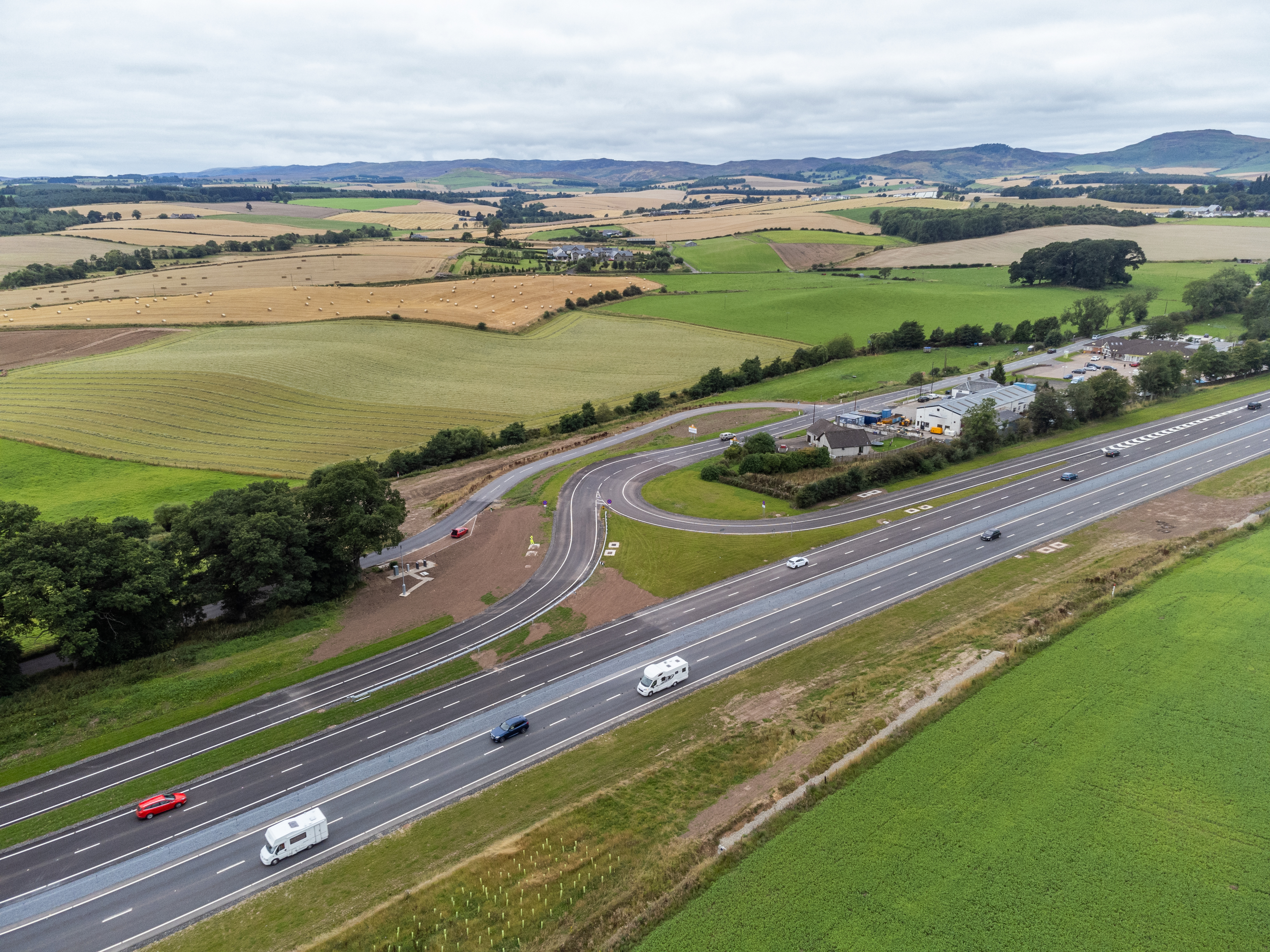
Tie-ins to the local road network were completed at the B9099, the C408 Stewart Towers Road, the B867 and the U116, and the existing Pitlandie Farm road was stopped-up in early July.
The surfacing of the bridge decks at Coltrannie and Gelly overbridges was completed in July and August. Once surfaced, the contractor was able to focus on the planting and landscaping of Gelly overbridge, known as the ‘green bridge,’ which, when complete, will provide an enhanced environment for wildlife to cross the A9.
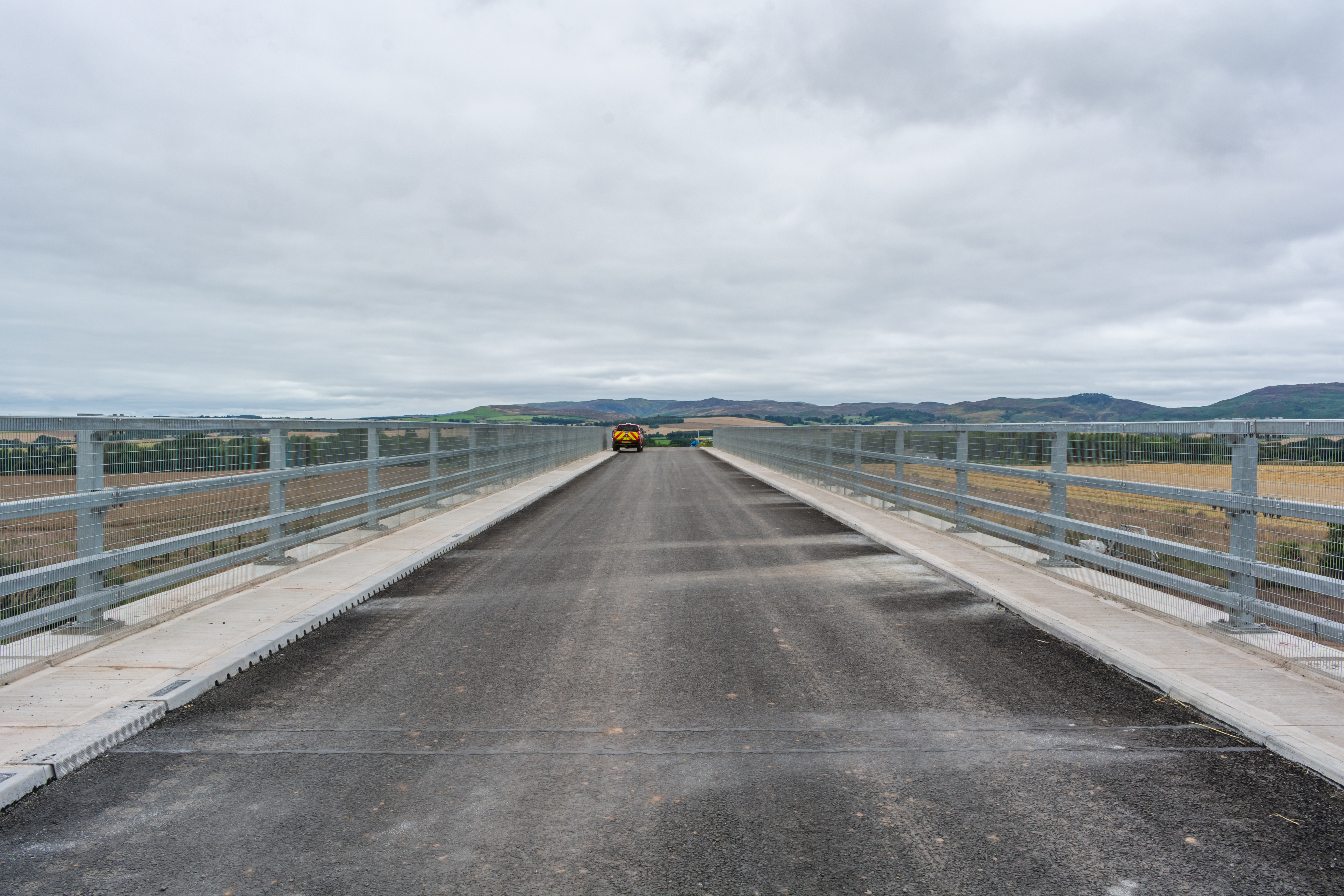
The erection of permanent stock fencing has continued throughout the summer months at various locations on the site and the installation of Intelligent Transport Systems (ITS) fibre cables got underway along the northbound and southbound carriageway verges. These cables will allow information to be communicated within the trunk road network, such as information for Variable Message Signs (VMS) and other intelligent technology for monitoring of traffic flows and volumes. The VMS signs and CCTV masts were also installed throughout the summer months.
However, the main event of summer was undoubtedly the removal of all traffic management on the A9. On Saturday 28 August, lane and speed restrictions were lifted allowing road users access to the 9.5 km of new dual carriageway between Luncarty, north of Perth, and the Pass of Birnam for the first time.
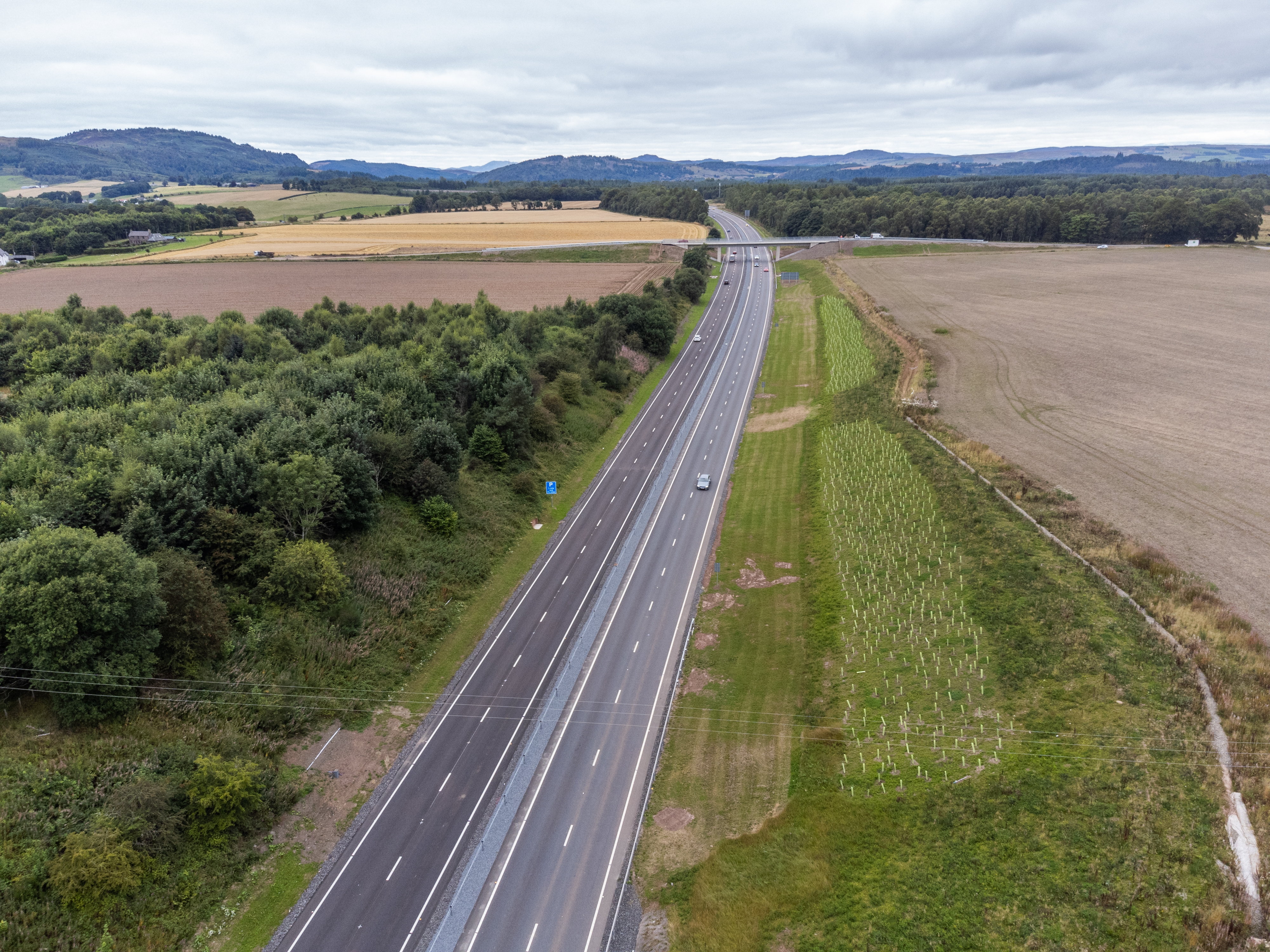
The opening of this section to four lanes of traffic, the most southerly section of the dualling programme, now provides 15 km of continuous dual carriageway from Inveralmond Roundabout to Birnam.
This important project milestone also included the opening of 4 km of new and upgraded non-motorised user route which now connects the surrounding communities to Scotland’s core path network. The routes will promote active travel and encourage people to walk, wheel and cycle for everyday journeys. View the new non-motorised user (NMU) route between these communities.
Following the opening of the new dual carriageways, the contractor is continuing to undertake finishing and landscaping works throughout the project, which may on occasion require some traffic management to allow works to be undertaken safely.
Spring 2021
Good progress has continued to be made across the site.
At the southern end of the project, road markings and verge finishes were completed in advance of the traffic being switched onto the new A9 southbound carriageway in early March, while earthworks to the west side of the new Stanley/Tullybelton Junction were completed.

The project team began installing drainage on the side road to the west of the junction during April and commenced construction of Tullybelton Road, which connects the east and west via the new A9 overbridge at the new Stanley/Tullybelton Junction.
Topsoiling works progressed at pace and were completed in April. The new road sub-base and surfacing works continued throughout May, in anticipation of the junction becoming operational.
Works also got underway near Pitlandie at Ordie access track, to the south of the site, which involved realigning and kerbing the new side road as it passes beneath the railway viaduct.

At Pitlandie overbridge, kerbing and pavement was laid across the new bridge and barrier installed allowing the overbridge to be used by local traffic. Meanwhile, the installation of Intelligent Transport System (ITS) equipment, which includes closed-circuit TV cameras (CCTV) and variable message signage (VMS) commenced on the west side of Pitlandie. This equipment provides road users with real-time journey information.

At Bankfoot South Junction, works continued on a sewer diversion on the project which concluded in May and surfacing continued on the new slip roads at Bankfoot South Junction.
The final section of the existing A9 carriageway was planed out on the northern section of the project in early Spring, allowing the remaining sections of drainage works on the new northbound A9 carriageway to get underway.
Following this drainage installation, the carriageway construction on the new A9 northbound carriageway continued with the various layers of road pavement being laid to the north of Hunter’s Lodge underpass at Bankfoot North Junction.

Alongside the construction of the new carriageway, works to fill the verge and central reservation with gravel and general finishing works continued. These works will allow the construction of the final layer of surfacing to commence on the A9 northbound carriageway. The installation of the central reserve barrier also commenced in the period.
At Coltrannie overbridge, works continued to surface the approach roads to the bridge and construction of a drystone wall in the area recommenced into May.

At Gelly overbridge, the installation of drainage was completed allowing surfacing works to progress. Works also commenced on the SuDS feature to be provided, south of Gelly overbridge.
Winter 2020/21
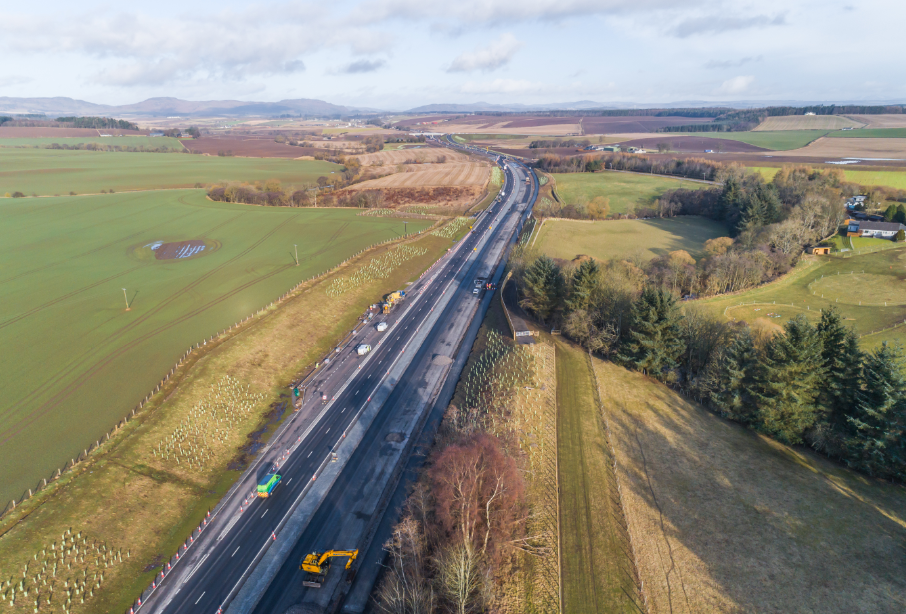
Good progress was made with construction of the new southbound carriageway continuing at the southern end of the project which included laying the various layers of cement bound and asphalt material required to create the new road surface.

Work also progressed in this area to create a new footpath/cycleway in parallel with the A9 carriageway, forming part of the new link for non-motorised users, connecting Luncarty and Bankfoot. More information on Active Travel and the new route being constructed as part of the project can be found here.
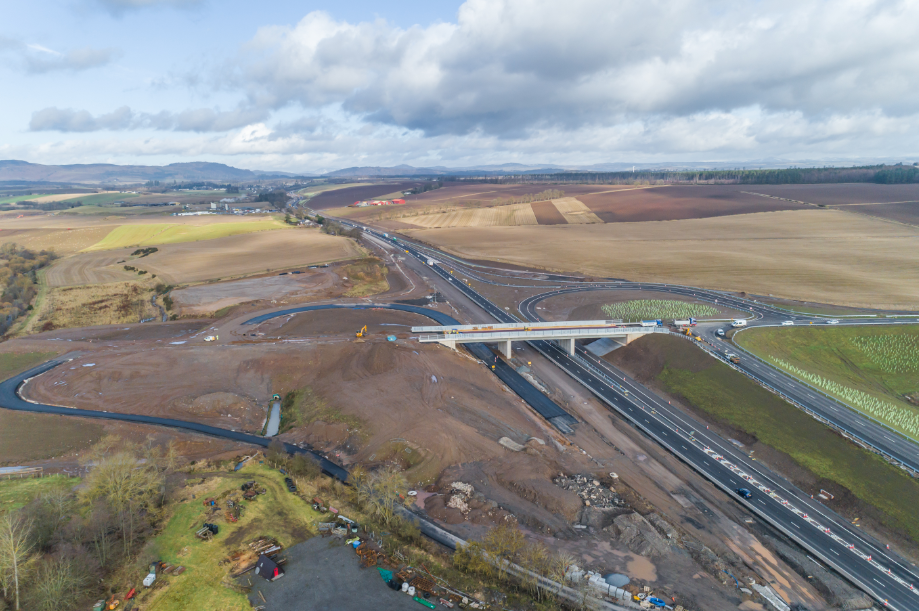
At the new Stanley/Tullybelton Junction, operations focused on the northbound slip roads with drainage and foundation layers being installed ahead of asphalt surfacing on the diverge slip-road.
Between the new Stanley/Tullybelton Junction and Bankfoot North Junction, drainage works continued to progress in the period and were installed for the new northbound carriageway.

Preparation work was able to get underway to construct the new Bankfoot South Junction in December, with traffic switched onto a temporary diversion at this location prior to the Christmas period. Moving the traffic away from the main junction has allowed several operations to commence here including drainage works for the A9 carriageway, slip road drainage and essential utility diversion works including BT, Scottish Water and National Grid.
At Hunter’s Lodge in Bankfoot, surfacing work was completed to the northern footpath on the C408 following the installation of utilities and the final structural concrete pours to upgrade Hunter’s Lodge overbridge were completed in December, with finishing work being undertaken in parallel.
To the north of Bankfoot, drainage work progressed alongside planing of the existing old northbound A9 carriageway to remove the old surfacing in advance of the road being upgraded. In order to upgrade the existing A9 between Bankfoot North Junction and the northern extent of the project, widening of existing foundation layers was required in advance of the main carriageway construction. Good progress was also made to divert utilities with new cabling and ducting being installed in this area.
The construction team also progressed several side roads and access tracks throughout winter. Road pavement layers were constructed to the side road and access track to the east of Pitlandie overbridge along with the access track to Newmill farm, adjacent to the Stanley/Tullybelton Junction.
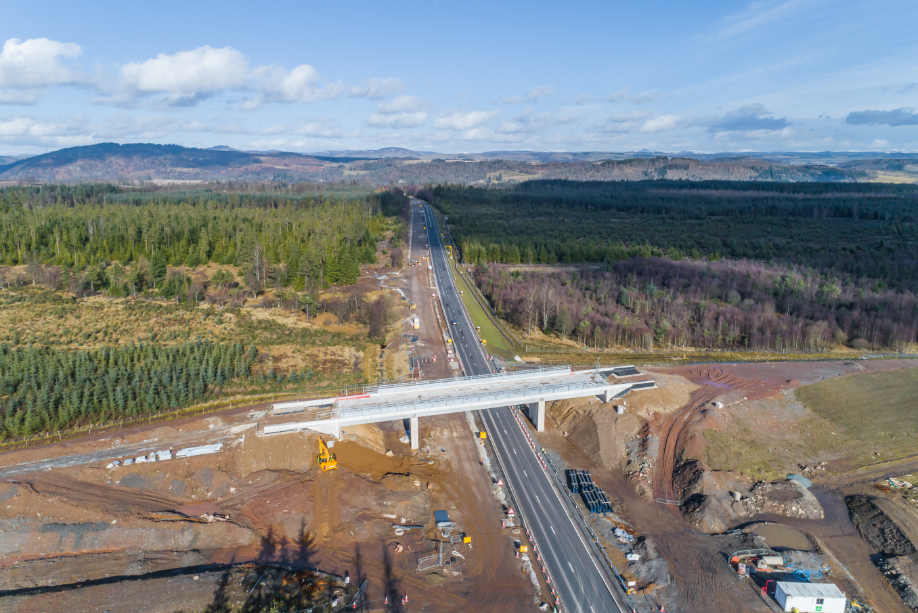
December saw the final structural concrete pours on the project at the Gelly overbridge in the north of the project. Operations on the structures across the project, such as waterproofing and finishing work, recommenced in late February alongside the sand-carpet layer to the Stanley/Tullybelton overbridge, which is placed above the concrete bridge deck in advance of the asphalt surfacing.

Progress continued on landscaping to the embankments adjacent to the Stanley/Tullybelton Junction through the winter months, where the weather conditions allowed.
Autumn 2020
Road surfacing works progressed at pace along the mainline A9 with significant progress noticeable at various locations throughout the site.
Works continued to construct the slip roads at the new Stanley/Tullybelton Junction and the Luncarty Link Road throughout September, and by the end of the month, the new Luncarty Link Road was opened to traffic for the first time.
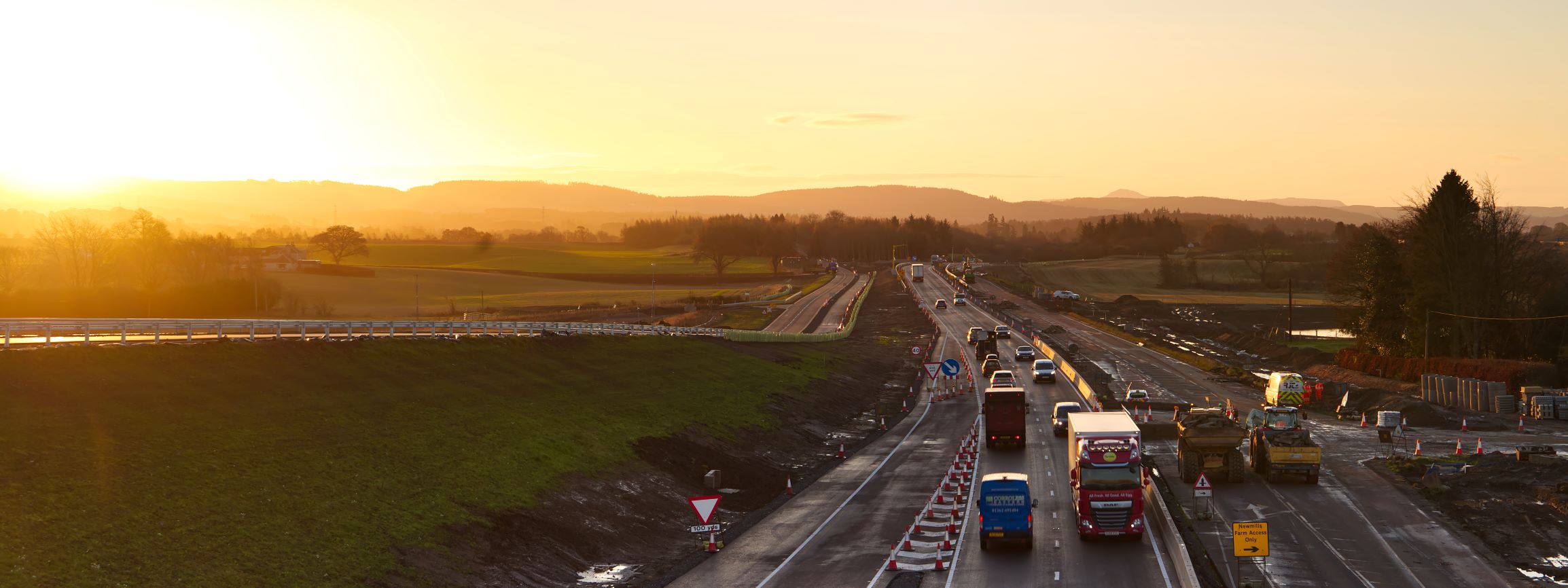
Surfacing of the new southbound A9 carriageway continued between Bankfoot North Junction and Luncarty North Junction ahead of a new phase of traffic management. As part of this new traffic management arrangement, A9 traffic was successfully switched onto this new section of carriageway between the two junctions on 17 November, meaning road users are able to drive on new A9 carriageway for the entire journey through the works area.
This traffic switch allowed works to progress on several other key areas of the project. The contractor was able to commence works to upgrade Bankfoot South Junction and the now unlocked existing A9 carriageway between Luncarty and Bankfoot North Junction.
During the period, access from the A9 Northbound to the Bankfoot South Junction moved approximately 40 metres south to a temporary junction to facilitate the construction of upgrades to Bankfoot South Junction.
In addition, the slip roads on the east side of the new Stanley/Tullybelton Junction came into operation, providing access to the U38 Stanley Road and the new Luncarty Link Road, while the existing at grade junction to the north of Luncarty closed permanently.
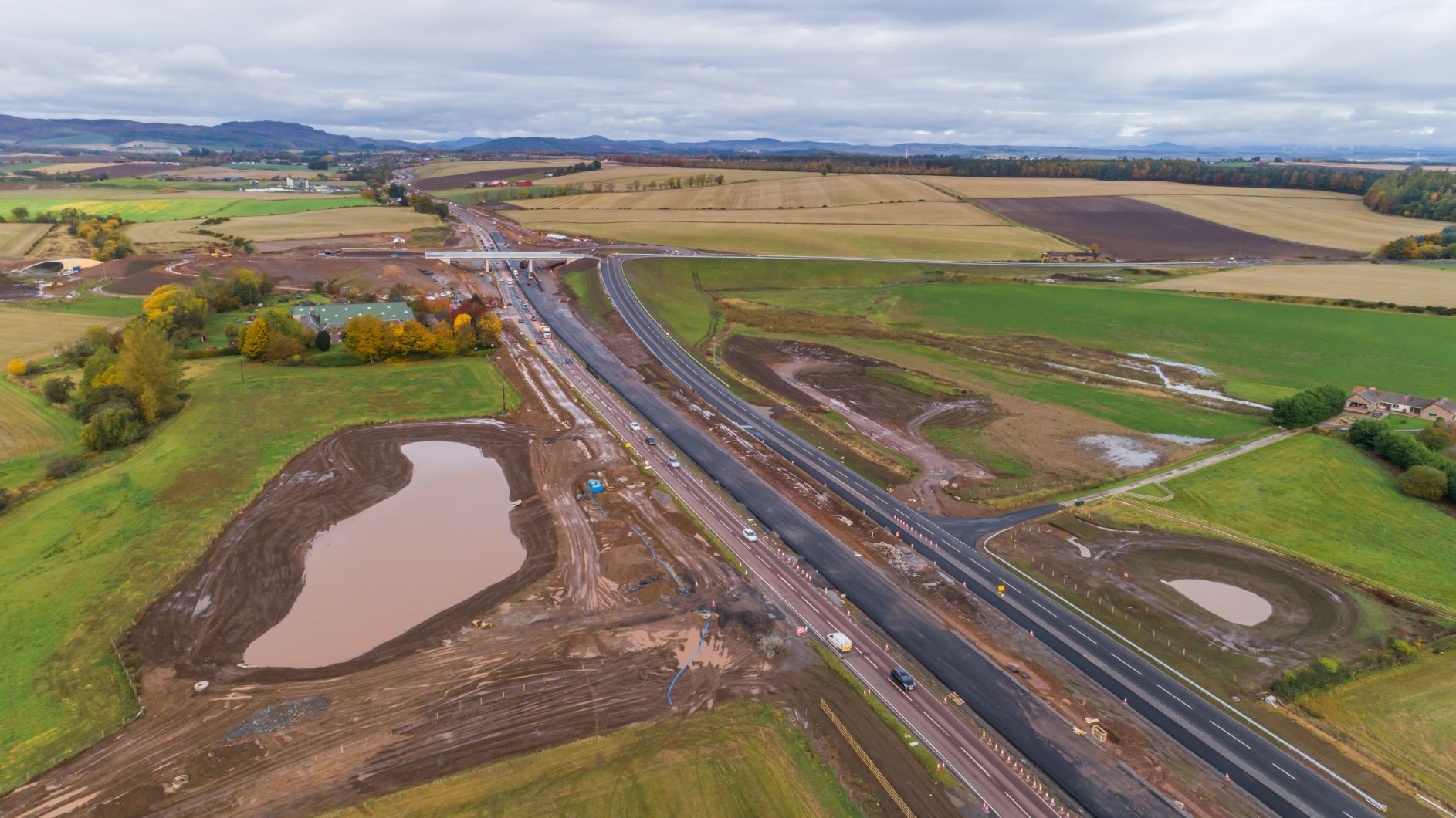
Works on the old A9 carriageway included planing off the old road surfacing. This is being re-used elsewhere on the project in the foundation layers of some of the access tracks being constructed as part of the works. Carriageway drainage and cross carriageway culvert installations were also progressed in recent months along the alignment of the old A9.
With the bulk of the works to the structures completed earlier in 2020, some finishing works were carried out in the period, including waterproofing of some of the bridge decks. Waterproofing and backfilling also continued on the BEBO arch structure which forms the new Ordie Burn overbridge to the West of Newmill Farm.
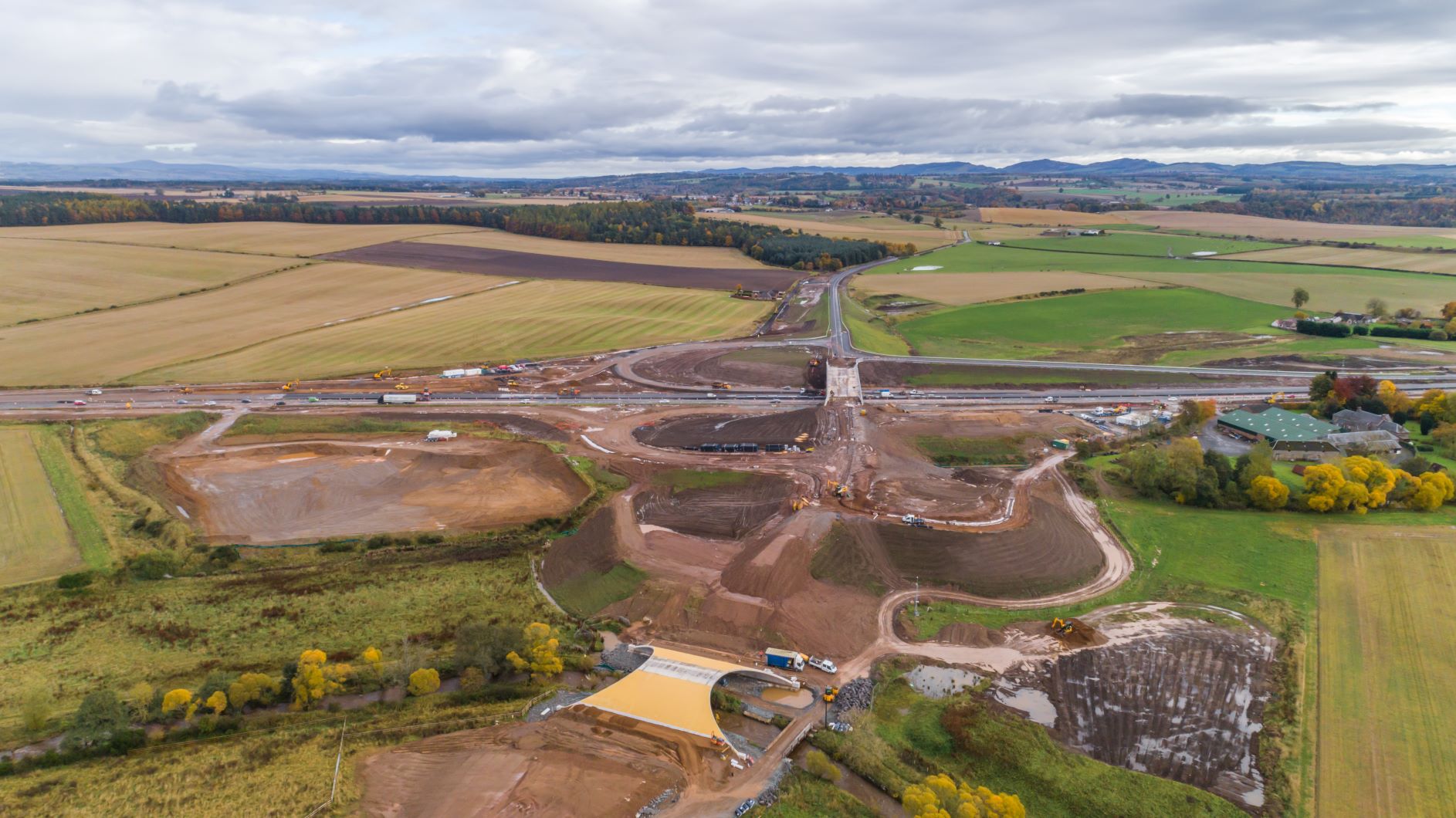
Landscaping has also continued throughout Autumn with new planting areas being completed on the large eastern cut slopes between Bankfoot and the new Stanley/Tullybelton Junction.

Summer 2020
The construction site remained closed, to ensure the safety of the workforce, due to the Coronavirus Pandemic throughout late Spring and into early Summer 2020. During this time, our contractor Balfour Beatty, provided a skeleton team to oversee essential services such as site safety and security, and to monitor the traffic management to ensure the safe operation of the A9.
By early June 2020, our contractor was able to proceed with planning and pre-start preparations on site, following the Scottish Government’s up-date to the construction sector guidance. This enabled the project team to undertake works to site offices and welfare facilities in preparation for construction restarting.
These preparatory works involved significant alterations to the site offices and welfare facilities to comply with Scottish Government guidelines on hygiene and physical distancing, and the development of a robust series of new operating procedures to monitor and control every aspect of the working day to keep site staff safe.

The project team welcomed the news that work could gradually recommence on site from 22nd June 2020, and with the new operating procedures firmly in place, construction began the very next day. Works commenced on plaNning out the existing carriageway surface between Luncarty North and South Junctions and new surfacing operations got underway at the northern end of the project, between the new Coltrannie overbridge and Bankfoot North Junction.
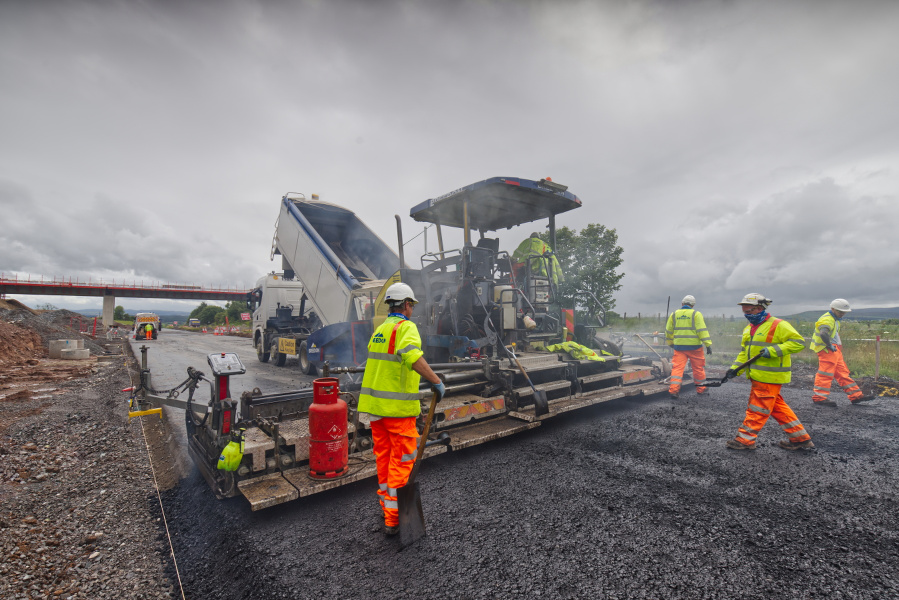
A new access track adjacent to the Pitlandie overbridge near Luncarty was completed and permanent fencing was erected at this location to de-lineate the highway boundary and keep animals away from the road corridor.
The structures team restarted works to the wing walls at Pitlandie and Coltrannie overbridges and poured concrete for the retaining wall at the Ordie burn culvert on the east of the A9 and south of Luncarty North Junction.
The earthworks teams prepared the foundation layer of approximately 4km of new southbound carriageway between Pitlandie overbridge and Bankfoot South Junction, with sub-base material also being laid in preparation for road construction. The slip roads on the new Stanley/Tullybelton Junction also began to take shape to the east of the A9 carriageway.
The project team took advantage of favourable weather conditions over the summer months to progress the surfacing of the A9 southbound carriageway. Significant progress was clearly visible to road users on the adjacent carriageway, as the new southbound carriageway extended over the top of the new Hunter’s Lodge underbridge extension at Bankfoot North Junction. Road users will soon see the completion of the entire southbound carriageway, with the exception of a short section around the Luncarty North Junction, required to maintain temporary access onto the A9 from Luncarty and Stanley.

Work continued to progress the construction of the slip roads at the new Stanley/Tullybelton Junction and the Luncarty Link Road in anticipation of them opening to traffic for the first time in Autumn when the U38 Stanley Road will also re-open to traffic.
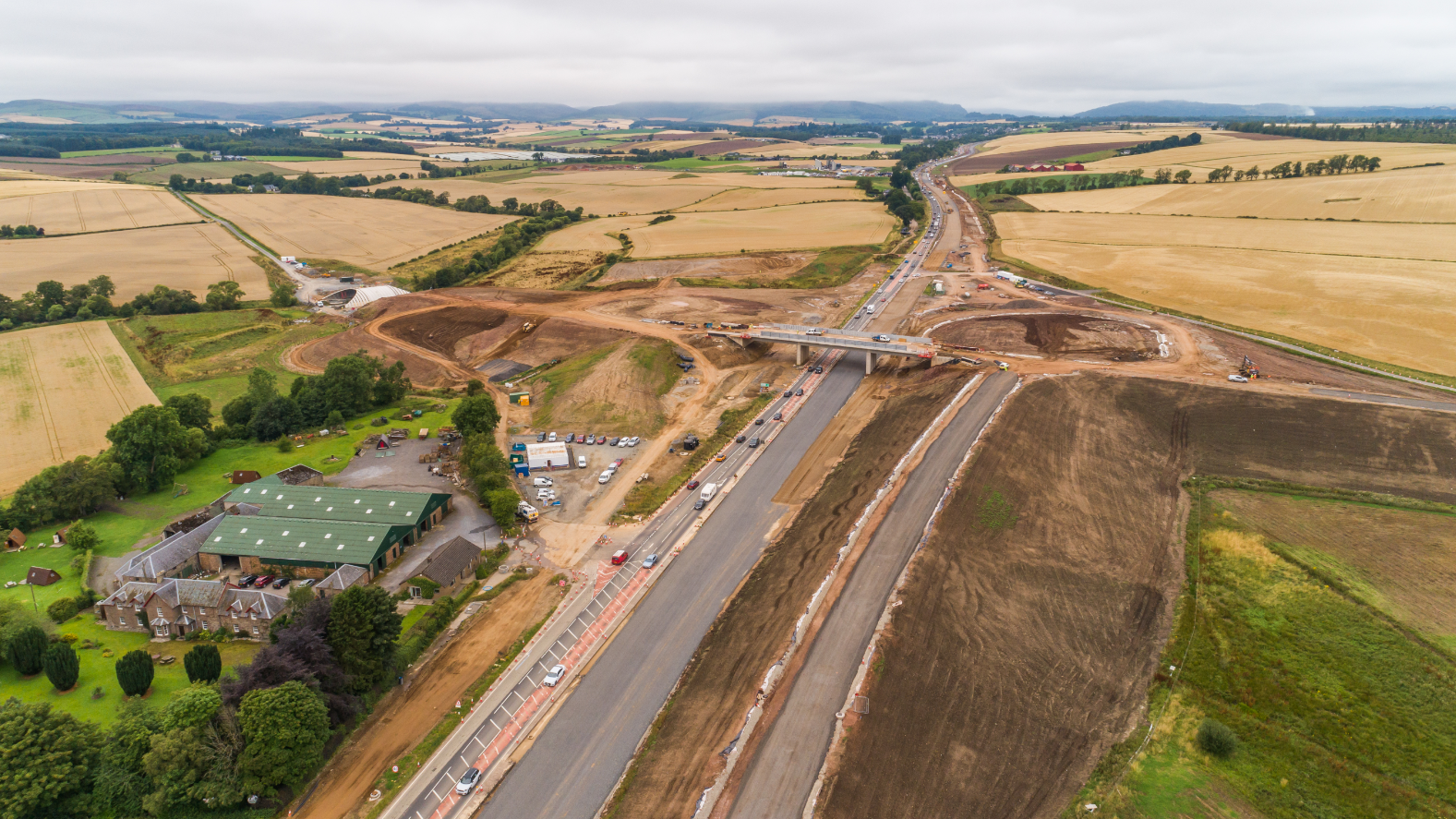
The project achieved an important construction milestone at the end of August as the traffic management team worked through the night to transfer traffic onto a new 3km section of the southbound carriageway from Gelly to Bankfoot North Junction. This key stage in the construction programme enabled work to begin on the existing carriageway, which will be removed and reconstructed to form the new northbound dual carriageway.
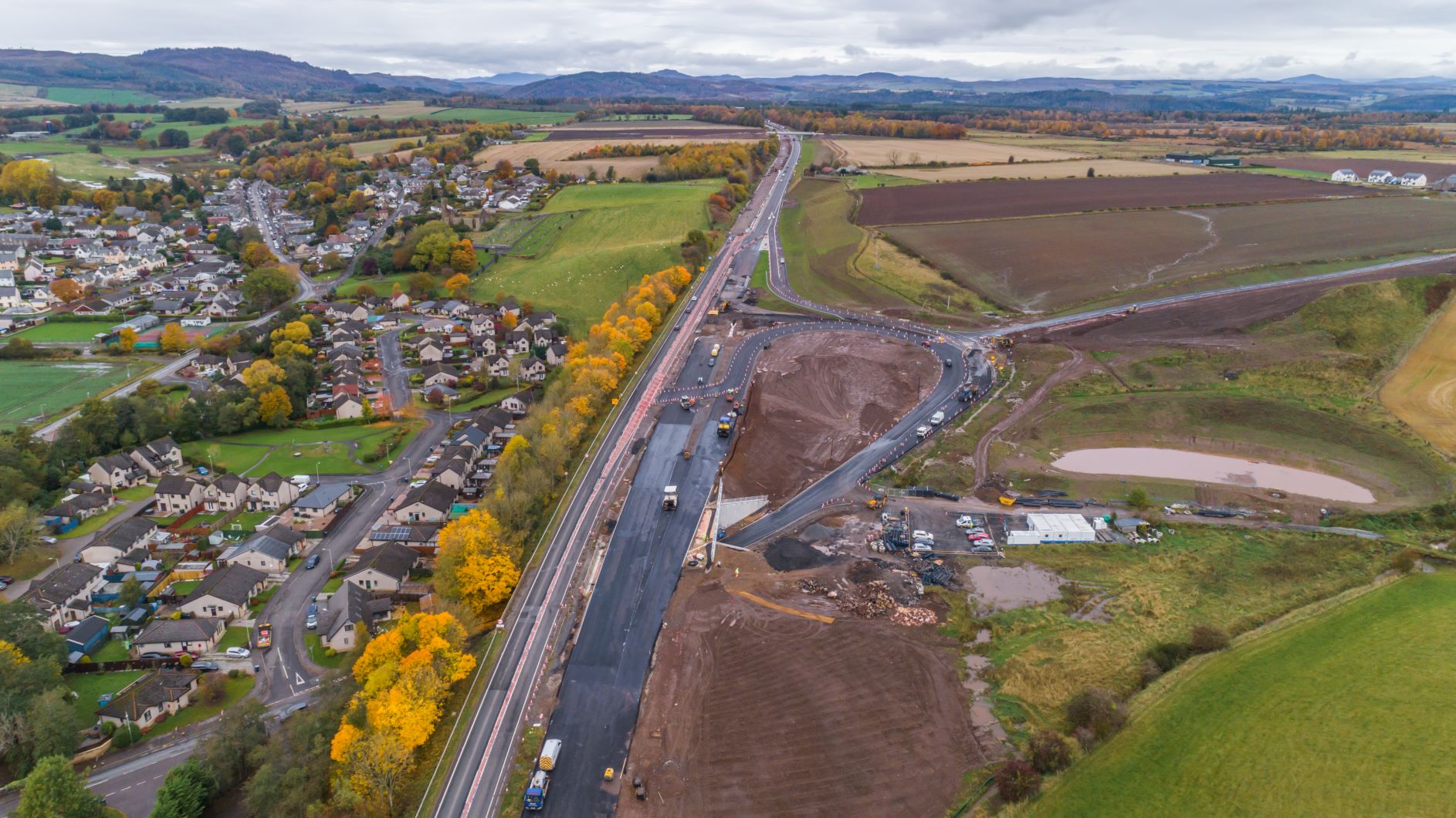
Work continued on the construction of the BEBO™ arch structure on the U32 over Ordie Burn which will replace the old stone bridge to the west of Newmill Farm.
The pre-cast concrete arch structure was completed and earthworks operations to backfill the area and create the approach embankments around the bridge commenced. The image below shows the impressive structure of the arch prior to it being covered with earth.

Spring 2020
Spring 2020 will be remembered for decades to come – when 'normal' life stopped to fight the spread of the coronavirus global pandemic.
Following the Scottish Government announcement at the end of March, our contractor Balfour Beatty implemented a managed shutdown of the site, in line with the Government guidelines including physical distancing.
The safe and secure shutdown of the site ensured that partially built structures and operations were made safe, associated equipment and plant were properly stored and security measures were put in place at site compounds for the duration of the site closure.
During this time only essential services were permitted, such as monitoring the traffic management to ensure the ongoing safe operation of the A9 as a key part of the national trunk road network.
Despite the interruption to this major infrastructure project, significant progress had been achieved by mid-March when the final sets of beams were lifted into placed at Bankfoot North Junction. These beams completed the extension to Hunters Lodge underbridge to accommodate the new A9 southbound carriageway.

Following the successful traffic switch at the southern end of the project in February 2020, the roadworks focus then shifted to the northern section, with 3,500m3 (8,000 tonnes) of Cement Bound Granular Material (CBGM) laid as the base of the new road, and more than 1,600m3 (4,300 tonnes) of new surfacing placed to create more than 1km of the new A9 southbound carriageway.

Drainage operations continued to progress between the Stanley/Tullybelton junction and Bankfoot, with the excavated material from the creation of drainage channels being reused as fill elsewhere on site. This sustainable method of working has resulted in 99.9% of the materials required for the likes of earthworks operations, being recycled and re-used on site as of the end of March.
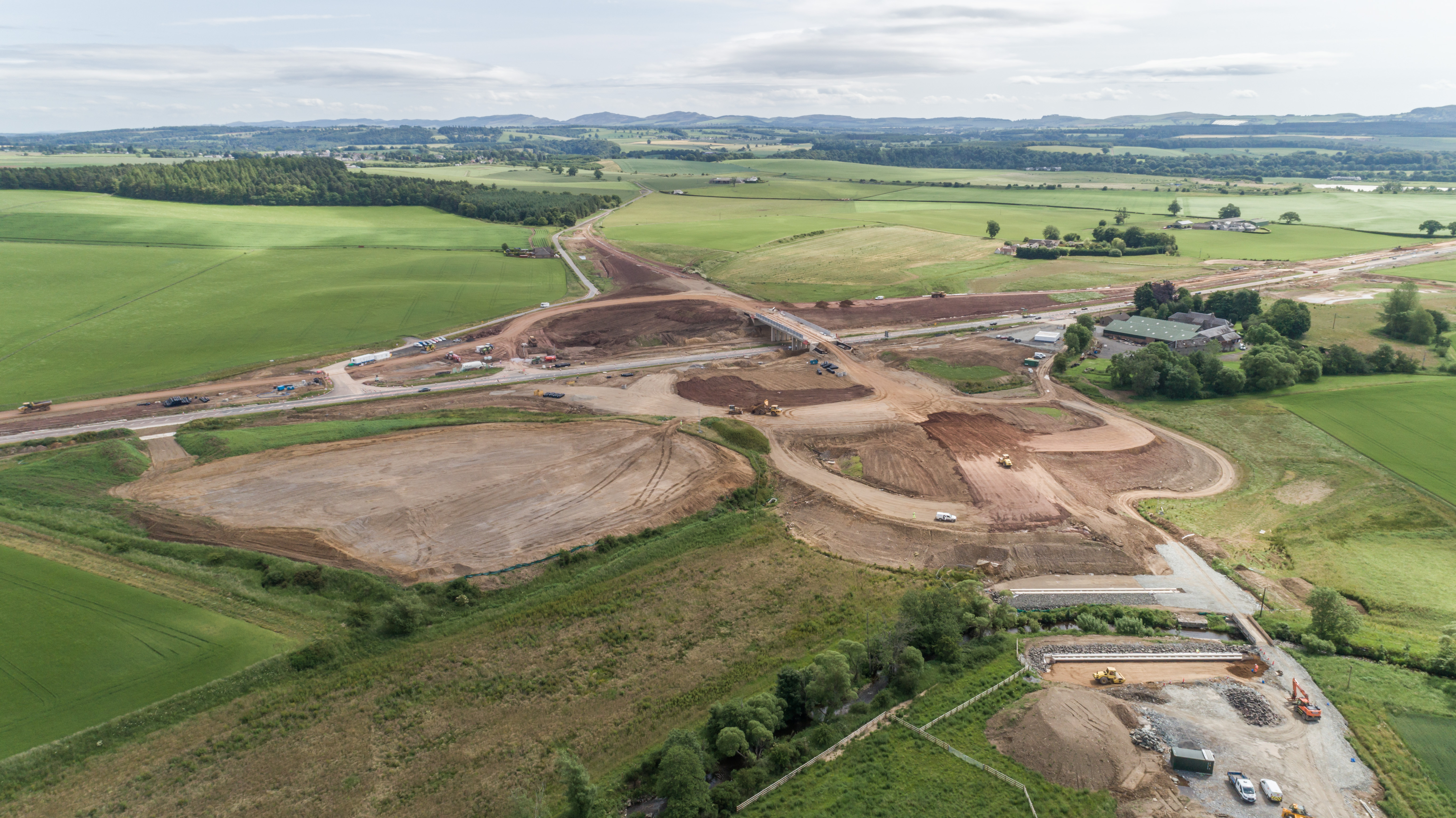
Similarly, Balfour Beatty’s initiative to locate a borrow pit on site at Newmill Farm has dramatically reduced the number of vehicle movements on the road network that would have been necessary to transport thousands of tonnes of materials including gravel and sand to site. This has resulted in a more environmentally sustainable method of constructing major infrastructure of this scale. The excavated materials from the borrow pit have been used to construct the road embankments around the Stanley/Tullybelton Junction.

Works on the structures progressed well with concrete for the bridge decks being poured at several structures. With all the concrete beams now installed as planned on the project, completing the bridge decks will allow our contractor to begin to undertake waterproofing and surfacing, in preparation for them opening to traffic.
Preparatory works also began on the new Ordie Burn underbridge which will replace the existing stone bridge to the west of the A9 near Newmill Farm and the new Stanley/Tullybelton Junction, with a BEBO Arch bridge. This unusual structure, will comprise 50 precast concrete sections, to form an arched bridge over the Ordie Burn.
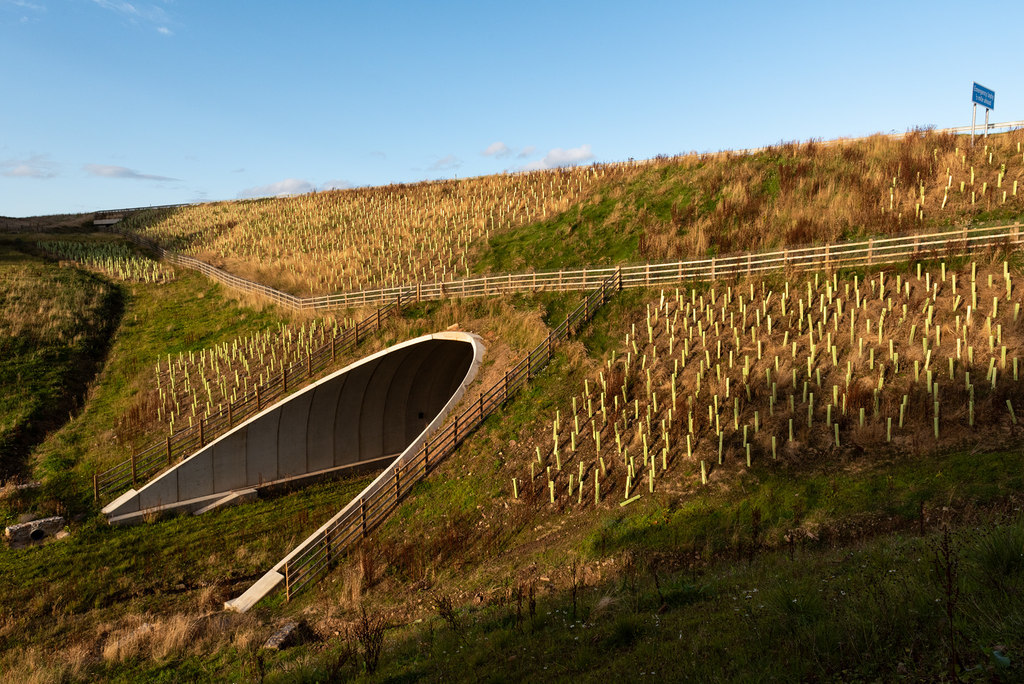
An example of a BEBO® Arch constructed over Limpet Burn as part of the Aberdeen Western Peripheral Route
Winter 2019/20
Despite adverse weather creating challenging working conditions in February, bridge beam lifting operations at Gelly overbridge were successfully completed during two overnight closures of the A9 on 18 and 19 February, rather than the three nights originally planned. The project team were able to carry out the finishing works to the beam lift operation on the third night under temporary traffic lights, which minimised disruption to road users allowing the road to remain open overnight on the 20 February.
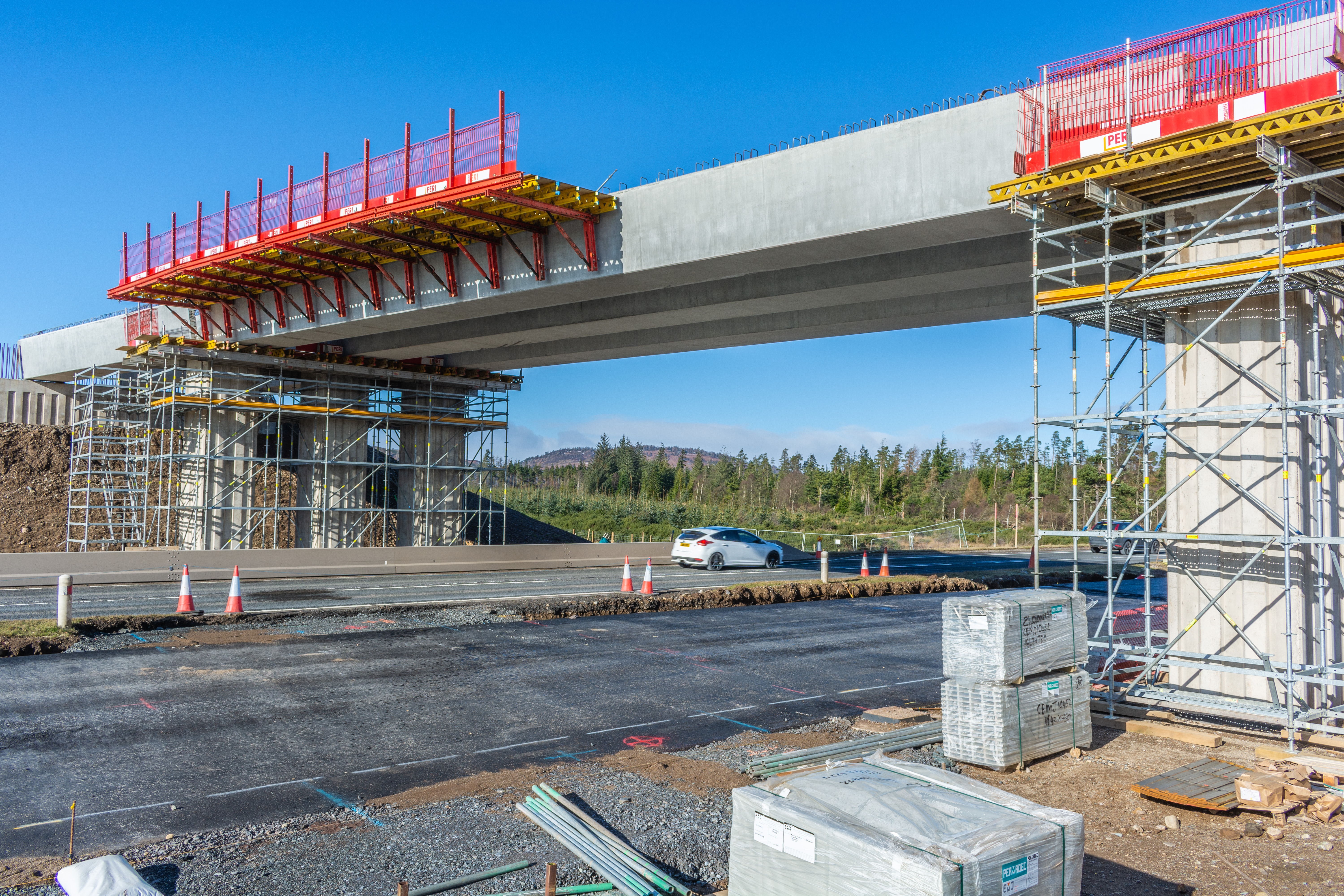
In addition, the project achieved a significant milestone during February with traffic being switched on to the new section of northbound carriageway at Luncarty Junction for approximately 2.4km. The focus will now shift to the new southbound carriageway at the northern end of the project.
During Winter 2019/20, the project team have been busy laying cement bound granular material (CBGM) as the base of the new southbound carriageway.
Work also continued on the installation of the drainage network, tying in new road drainage to the network of Sustainable Drainage System Ponds (SuDS) that have been constructed throughout the project, some of which are now visible to passing road users.
Earth moving operations continued at Bankfoot North Junction during January and February with some 27,000m3 of earth placed in the vicinity of the new Hunters Lodge Underbridge extension. This material is being excavated from other areas within the site to fill the area surrounding the structure.
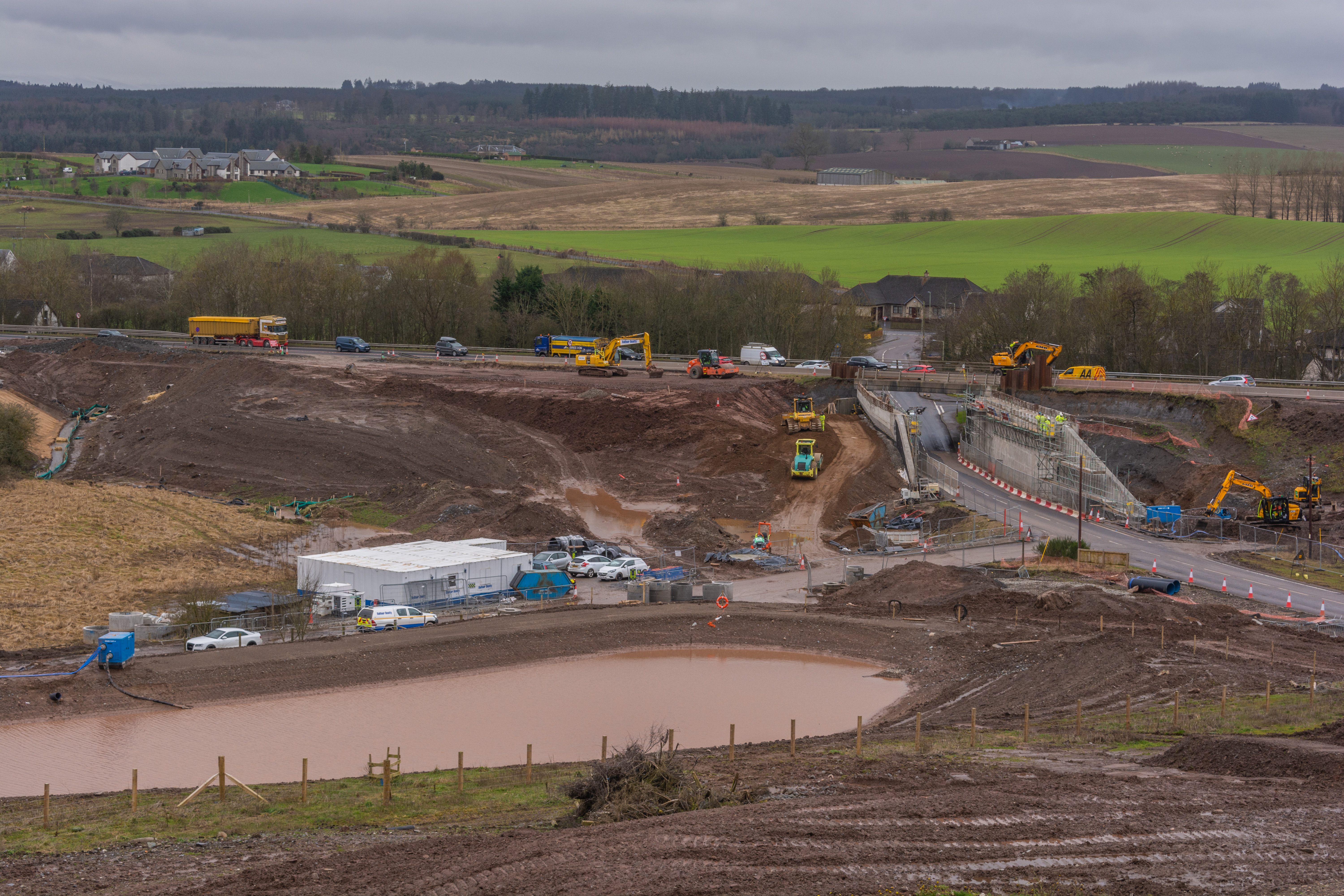
The construction of the concrete bridge decks at the Pitlandie and Coltrannie overbridges, following their beam installation in late 2019, has also progressed within the period. The concrete deck at the new Stanley/Tullybelton overbridge was completed allowing site traffic to transport material over the A9 without affecting road users.
Landscaping works also got underway and road users and residents will have noticed that several hundred trees have now been planted on the verges and slopes adjacent to the newly constructed carriageway.

Autumn 2019
During Autumn 2019, the project moved into another exciting phase with the first layers of the new road being laid at the southern section of the site, between the Luncarty and Stanley junctions. Road users can now see the new northbound carriageway as they travel north of Luncarty.

Once the southern section of the pavement operations are complete, surfacing operations will move to the north of the project to commence forming the new southbound carriageway working south towards Bankfoot.
Culvert extensions and head walls have now been completed including two large culverts at the Shochie and Ordie burns. The drainage adjacent to the carriageway was also progressed ahead of the new road construction which includes connections below the existing road. These connections allow the surface water run-off to flow to the SuDS (Sustainable Drainage Systems) ponds. In addition to the drainage, kerbing for the new carriageway has also commenced and road users will see this in place at the new carriageway north of Luncarty and also at the north end of the site, ahead of the new road being laid.
Earthworks for the project this period focused on embankment construction at the new Stanley/Tullybelton junction. The structures were also backfilled as the construction of the concrete supports and decks progressed.
The Tullybelton overbridge deck is now complete and now that the temporary supports above the carriageway have been removed, the final profile of the bridge deck is now visible to road users.
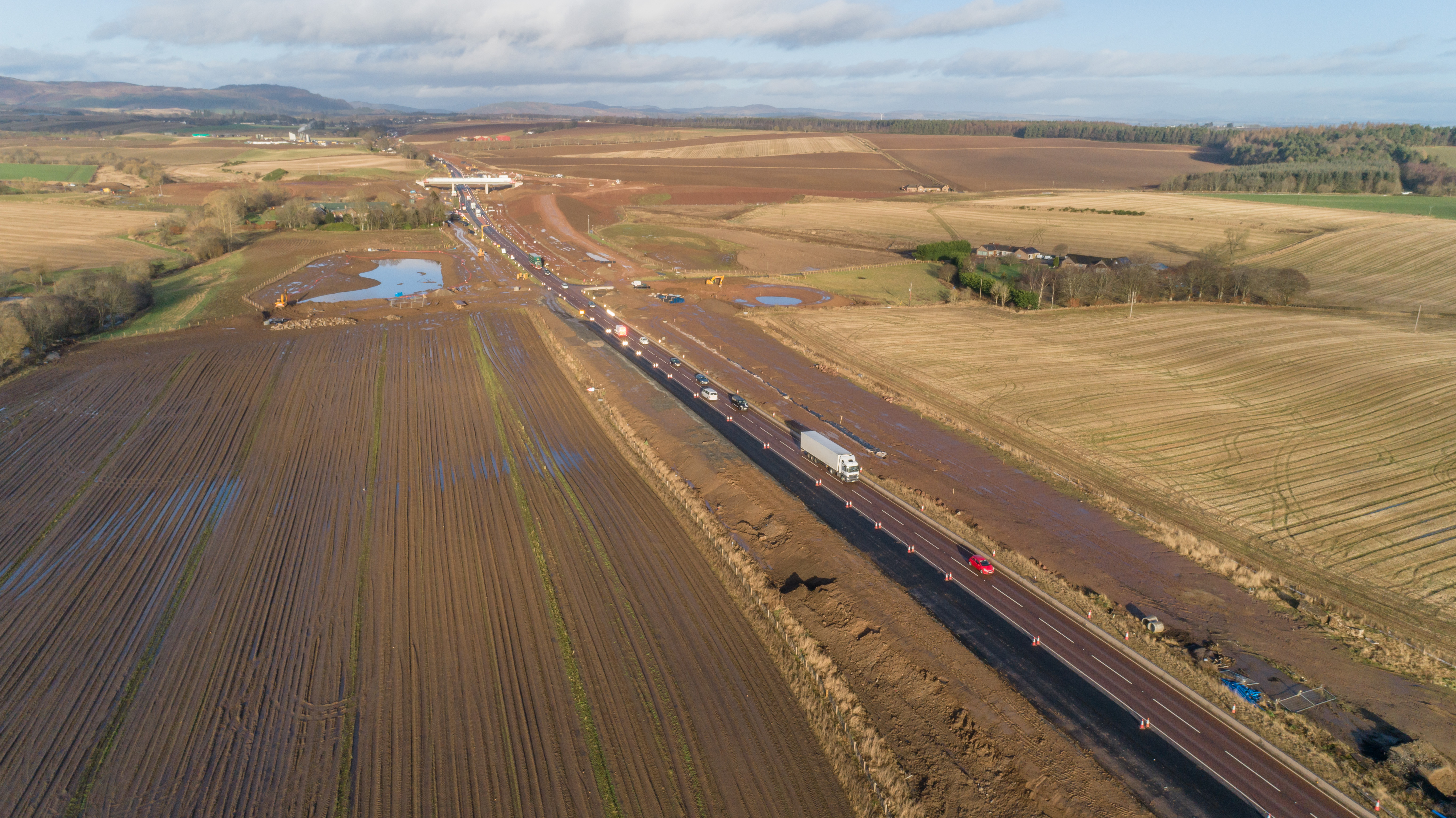
Good progress was made on two more structures, with the successful installation of precast concrete beams at both Pitlandie and Coltrannie overbridges during full overnight closures of the A9 at the end of November. These two important structures will provide new safer access for residents and farmers who live and work adjacent to the A9. These new accesses will also allow the existing accesses off the A9 to be closed to help improve road safety along this section of the A9. See a timelapse video of the beams being installed.
During the overnight closures works at drainage crossings and general maintenance of the traffic management were also undertaken along with refreshing temporary white lines at junctions throughout the site.
Summer 2019
The earthworks stage of the project continued throughout Summer 2019 with the majority of earthworks to the south of the new Stanley/Tullybelton junction nearing completion.
North of the Stanley/Tullybelton junction, earthworks continued with the excavated material from Bankfoot being used as fill material for the construction of the Tullybelton East junction. The earthworks around this structure included the shaping of the approach embankments on either side of the junction which will form the new slip roads to tie into the existing Stanley road. In total, approximately 610,000 m3 of material had been excavated by the end of August 2019, enough to fill 244 Olympic size swimming pools.
The traffic management for the site underwent a change in June 2019 as a temporary mini-roundabout was installed south of Bankfoot. The temporary mini-roundabout helps to manage the safe flow of traffic during construction of the new A9 dual carriageway.

The temporary roundabout allows site vehicles direct access from the A9 to the quarry located at Loak Farm which provides the materials essential for the construction of the project and reduces the volume of construction vehicles on the local road network, which would otherwise need to come from quarries further afield.
Carriageway drainage on the southern end of the project commenced in July which involved laying pipes along the length of the new carriageway. Drainage is a key part of any road network as it allows surface water to run off the new carriageway to designated collection basins, ensuring the safe operation of the road for road users.
Works continued at Shochie and Ordie Burns to extend these culverts to allow for the wider A9 dual carriageway.
The project reached a significant milestone at the end of July following three overnight closures of the A9 to allow the installation of bridge beams to construct the new Stanley/Tullybelton junction. A total of 15 beams weighing 765 tonnes - the equivalent of 60 double decker buses – were installed to form the new structure over the carriageway. During the month of August, work began on the construction of the deck of this structure.
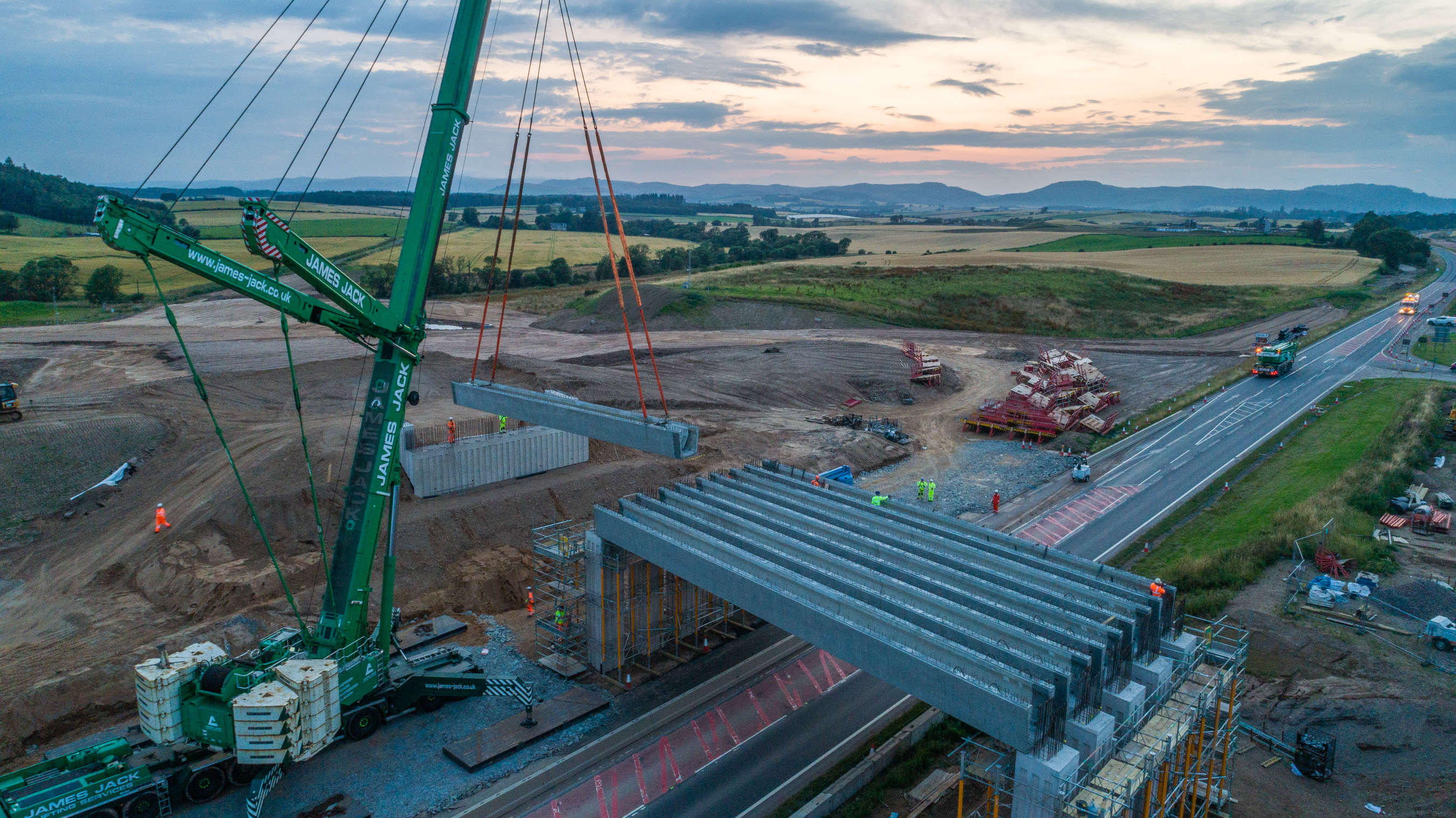
Construction of the concrete columns at Pitlandie, Coltrannie and Gelly overbridges progressed during August.
At Bankfoot North Junction, works to extend Hunters Lodge underpass progressed with the southern abutment cast.
The steep embankment at Broompark was cut to make way for the new dual carriageway. Soil nails were used to stabilise the steepened slope. Soil nailing involves drilling holes into the slope and fixing long steel bars into the holes with grout.
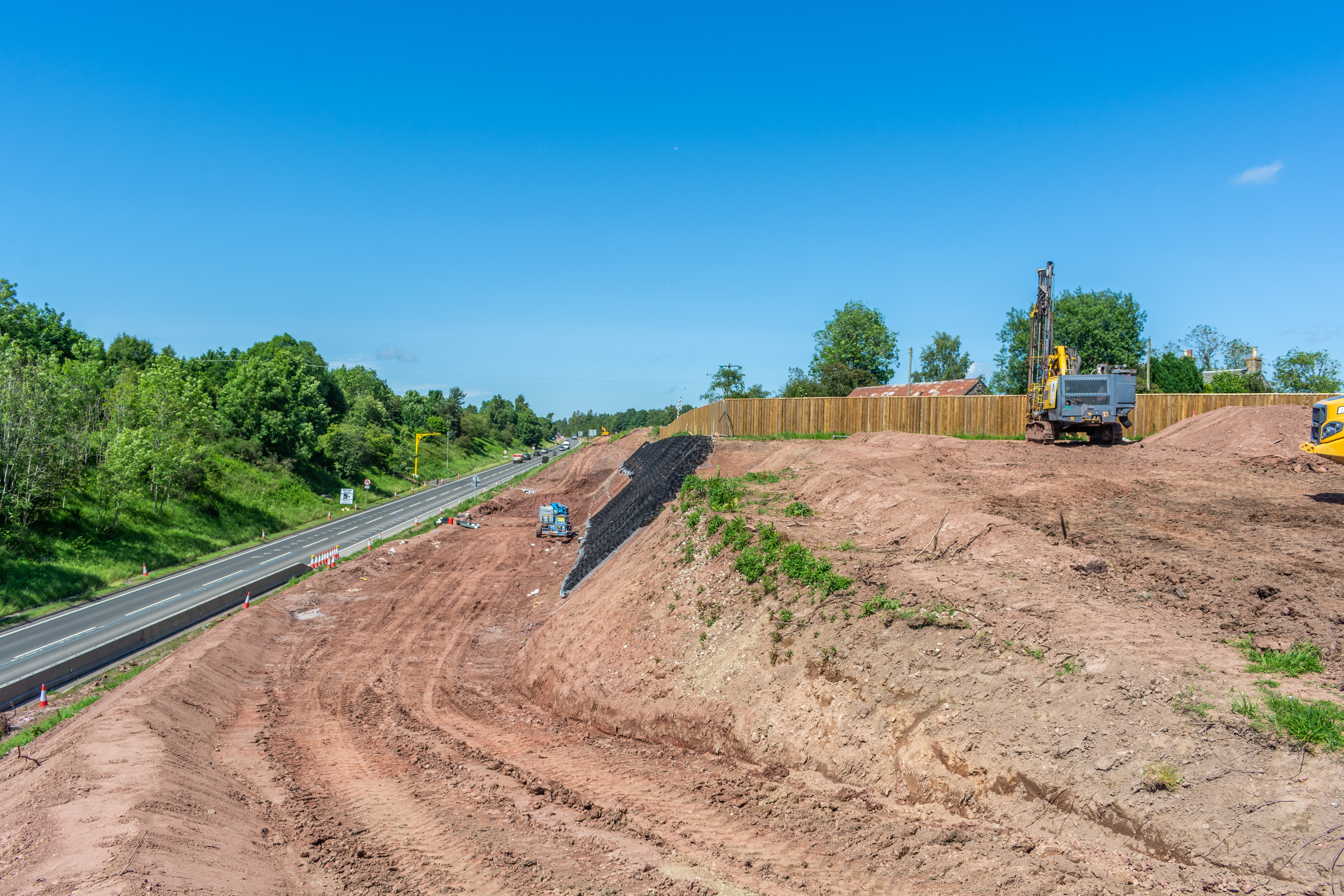
Further north of Bankfoot, site clearance and boundary fencing works continued, with earthworks commencing in the area to prepare for the construction of the two new overbridges at Coltrannie and Gelly.
The traffic management to the south of Luncarty junction was altered at the end of August to allow the first 2.4km of new carriageway to be constructed and tied into the existing dual carriageway. In advance of the new carriageway being constructed, drainage and foundation layers for the road were completed in preparation for the Cement Bound Granular Material (CBGM) being laid on this stretch.
The CBGM material is produced at the onsite batching plant adjacent to the project office at Loak Farm, along with some of the raw materials for the concrete and road pavement.
Spring 2019
Since the construction contract was awarded in September 2018, preparatory works including design, and construction works have progressed well during the initial months to June 2019. The project moved into the earthworks phase, where approximately 700,000m3 of earth is expected to be moved during summer 2019 season. That equates to approximately 280 Olympic sized swimming pools! The earthworks form the foundation of what will become the new widened A9.
The design of the dual carriageway has continued to progress, with more than 100 design packages delivered. Design packages are made up of many drawings and specifications which detail how each individual element of the project will be constructed.
To reach this crucial stage, our contractor consulted widely with a range of key stakeholders including Perth and Kinross Council, BEAR Scotland, Scottish Natural Heritage (SNH) and Scottish Environment Protection Agency (SEPA), to ensure that the needs of our stakeholders have been considered and included during design development.
Construction activity increased during the period and road users will have noticed a significant step-up in activity. This included:
- The new Stanley/Tullybelton Junction begun to take shape with hundreds of tonnes of earthworks placed to create the verges on both the east and west sides of the new A9. The overbridge also began to take shape in May, with both abutments formed and column construction underway ready for the pre-cast concrete beams to be lifted into place during overnight closures of the A9 in late July.
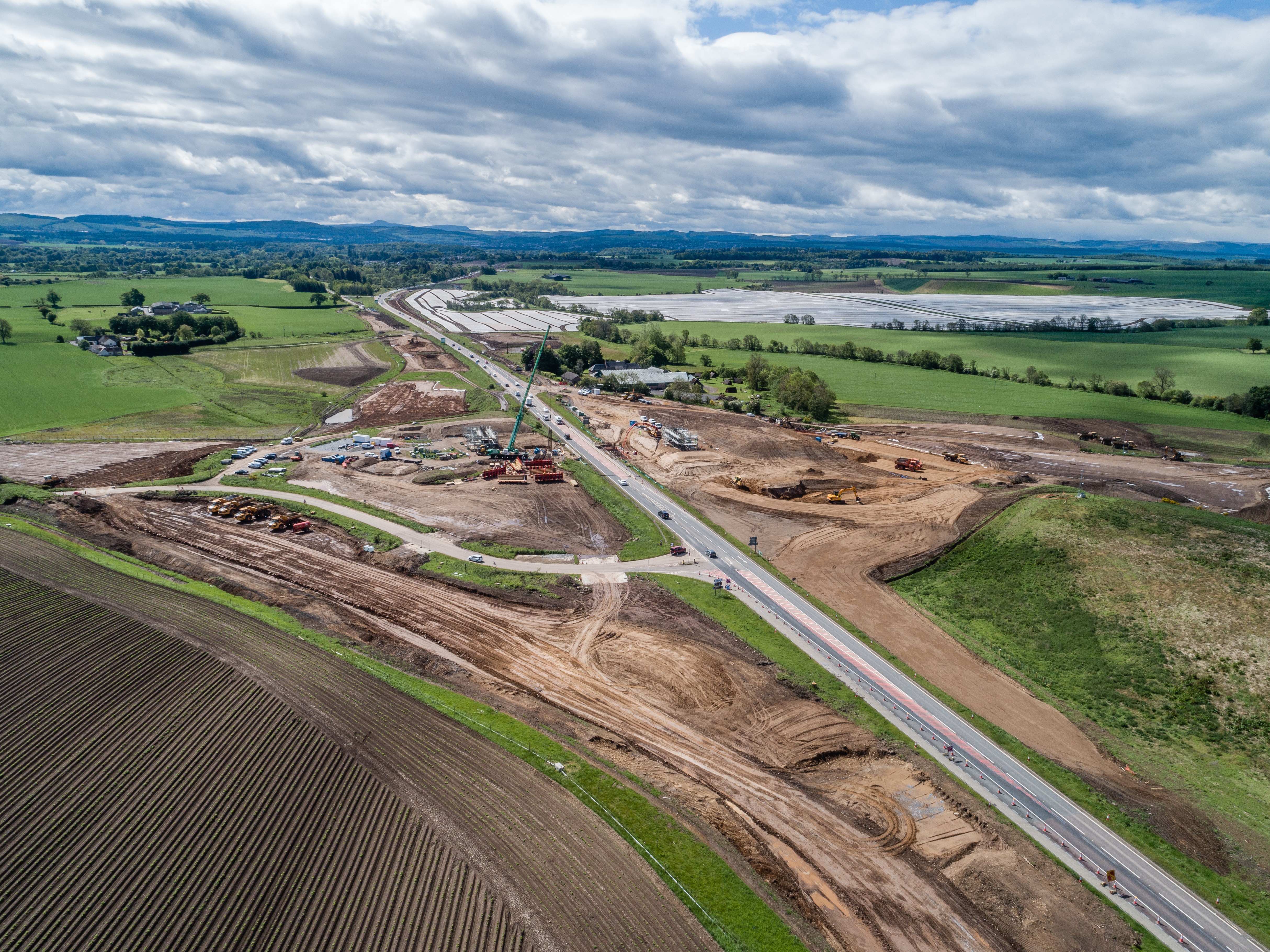
- Site clearance and boundary fencing works were nearing completion in all key areas of the site.
- Culvert extensions north of Bankfoot (which allow water to flow under the road) were completed to facilitate the widening of the A9.
- Public utility diversions such as BT cables were also well progressed.
- The temporary Bailey bridges installed earlier in the year crossing the Shochie an Ordie Burns became operational in April 2019. These Bailey bridges enabled our contractor to move tonnes of material to areas where fill is required, without having to use the existing A9. This has dramatically reduced the number of site vehicles using the A9, minimising delays to road users.

- To the north of Bankfoot, soil nailing works commenced on a slope in early May to retain the ground adjacent to a private property.
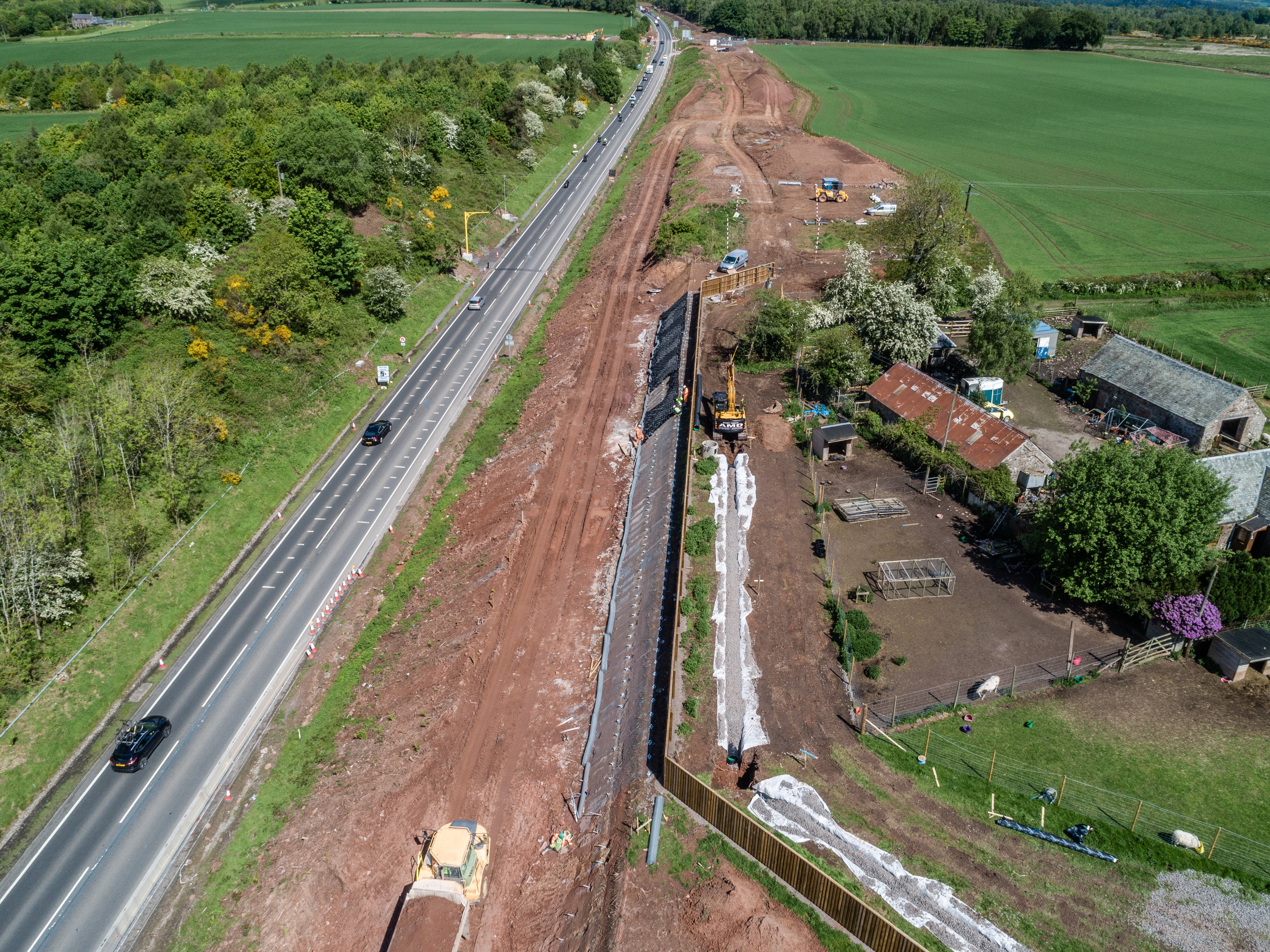
- At the northern extent of the project, construction also commenced at both Coltrannie and Gelly overbridges.

Community benefits
The A9 Dualling: Luncarty to Pass of Birnam project was delivered with an unprecedented focus on community benefits and a commitment to bringing meaningful and measurable change to the communities surrounding the project.
Details of some of these community benefits delivered by the contractor for the project, Balfour Beatty, Transport Scotland its partners can be found in the case studies below.
- Abertay University placements
- Academy 9
- Bankfoot Gala Day 2019
- Community Benefits conference
- Volunteering
- Stanley Development Trust
- Developing the young workforce
- Project RECCE
- Napier University
- Scottish Prison Service
- Bring your child to work day 2019
- Upskilling young people
- Project Charter
- Keeping the community informed
- School work placements
- Perth College (University of Highlands and Islands)
- Charitable donations
- Doors Open Days
- Apprentices
- Graduates
- Roving reporters
- Project Awards